#-how each one differs in the more subtle ways tied to background and theme
Explore tagged Tumblr posts
Text
I don’t really get this notion that Yuma is ‘just another DR protagonist’. For starters, he’s the only one in his group with amnesia and that’s a big part of the insecurities this time around- it’s identity issues, not just ‘normie who doesn’t belong with the rest of the group’. Obviously he hits some very similar beats, particularly to Hajime, but he handles in a different way to the DR folks in that he’s more uneasy about who he is, and he’s that much more dissonant over it
To put it in perspective, who knows how much memory he lost when he doesn’t even know how old he is much less anything to do with talent or objectives. Functionally, Yuma’s situation is the furthest from normal we’ve had so far, in a way that adds another dimension to the archetype
#offgame musing#yuma kokohead#raincode#not really an analysis- just a rant#Yuma is more comparable to Ryoko than the games' protags anyhow#and yeah it's fine if people don't like the archetype but. personally? i like to see-#-how each one differs in the more subtle ways tied to background and theme#so it just. idk. doesn't bother me as much?#plus Yuma's case being like#''especially odd' is more interesting to me#okay enough stewing in that#tag: Raincode
39 notes
·
View notes
Text
spoiler-free review of the assessment
on letterboxd i rated this movie 3.5/5
about delivery
i really enjoyed the visuals of this movie, i think fleur fortune is incredibly talented and intentional with her shots and lighting and tones, and so i think as a visual and tonal experience the movie is really beautiful. i also find that in that kind of art, what you receive from it is implied rather than explicitly said. so for example the themes and important parts of the movie are things you will pick up and just feel it, rather than having any way to even verbalize how you know you know the themes and tone
i had fun taking my creative interpretations of the movie as far as i wanted to since i knew i could trust the movie's creative vision and expression
however there are a lot of important and major parts of the movie that you take away on your own as a creative audience, and so because of that you don't feel very much connection with the characters or what they do or how they interact with each other
i understand as a viewer why the flow of the story happened the way it did; i understand that mia and her husband were directly dichotomous of each other as they were both creators, with mia being a talented botanist and aaryan being some kind of ai developer, i understand how women and their bodies were portrayed as connected to a natural world, which is to say women and their freedoms are portrayed from nature itself, how the world being pushed to it's artificial extreme connected to constraint of the woman
the way these important things are told to the audience is told beautifully, but to me i felt there was another aspect to the movie that was missing. the movie and the characters all portrayed an intentional message, but there was a humanistic aspect about it that i felt was missing, as in you don't really see interacting people in the movie but rather pieces of a subtle art, and as a viewer you don't feel yourself very connected with them either, and after the movie, connect more with the tonal elements and general themes of the story rather than the characters in them
i guess that's also to say that the movie isn't being told by the characters, which almost makes you feel a little unsatisfied but only because of that
about the story
i think this part will be more about my own biases as a viewer and things about what i searched for in stories based on what interests me
to talk generally to start with, i think the dichotomy between mia and aaryan, and the woman (mia) portrayed as being symbolic of natural life was really smart and beautiful. it reminded me of de beauvoir, who talked about how the essence of woman is from nature, women are myths and magical and non-material, their essences and how women truly are by their nature cannot be tied to social or cultural expectations or institutions. i really liked that part of it, and felt sad when no one in the interviews really mentioned something like that
lizzie said it wasn't only about women but also how we are treating the world and how this connects to social institutions and the state, but i have to say for it all to connect to childbirth is very feminine, and mia being a botanist of the most beautiful greenhouse in the middle of the desert is so intentional. i think this may also just be my own biases and interests but it can be said that the movie talks about the state and society and the world, but to me, focus on mia, how there is this really beautiful background music and also sound effects of her breathing, and the theme of childbirth kind of has all of that centralized around the woman
so i think the movie has women at its centre, and if there is any focus on the state and the world also (which there is ofc), it's done with the intention of contrasting the woman
about the dichotomy between aaryan and mia. i think this was carried out really nicely and i think the visuals of all of that difference was so gorgeous — mia's greenhouse is so beautiful and lush, and aaryan's workspace is literally pitch black nothingness with a light at the centre
i said this before but i also just can't get over the freudian stuff, i think it was unnecessary and almost contrasts this whole theme of the natural world and natural life. freud's theories of the daughter and her parents do not occur by nature, they are direct results of gender expectations imposed and observed, and so i think that was just so off-putting to me and weird. but this is also my personal bias; i think his theories are often taken as objective for how popular they are and how smart he was about observing gender, so i can't really hold it against anyone for putting that into the movie so heavily
general (conclusion?)
there's much more i could say, but i really would be spoiling it all, like i think also there's something beautiful about how mia and the (fake child) assessor interacted, and i think it also means something when they connect and are gentle with each other. it's the most calm and natural part of everything, which is to say women being together, whether this is just women interacting and identifying with each other or mother and daughter, however women interact
the movie is beautiful and fun and very creative
i'll also say as a side that because the movie is so tonal and beautiful and tbh a little chilling and bizarre, it would be a very fun movie to watch while high and hopefully i can do that some time next year when it comes out
23 notes
·
View notes
Text
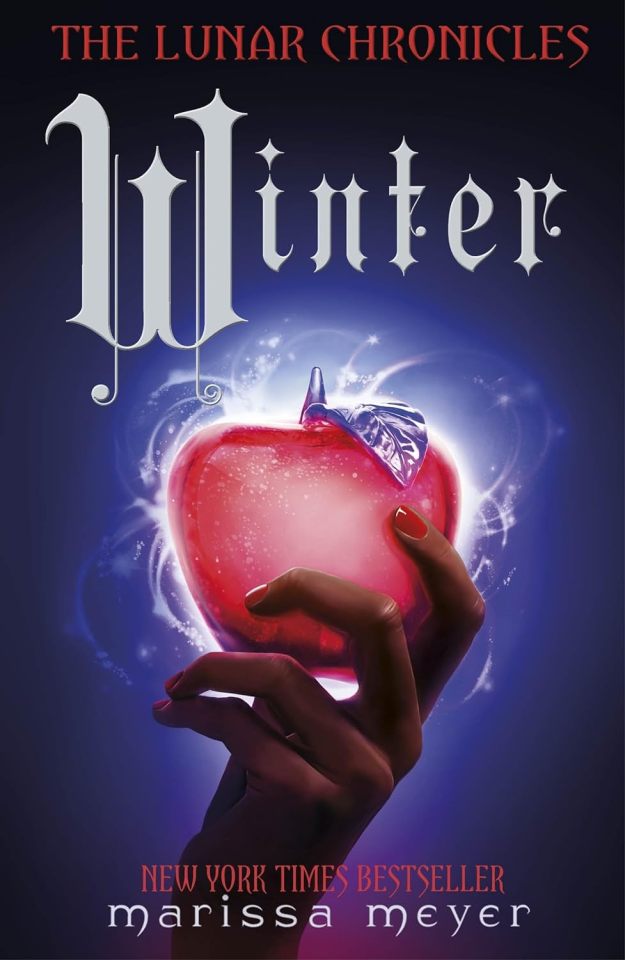
Winter by Marissa Meyer
5/5
What a beautiful story. I have nothing bad to say about this book. This might actually be the first time.
This is the sixth book I’ve read this year that was over 800 pages, but this is the first one that didn’t feel like it. It was perfectly paced and the plot didn’t feel overly complicated at any point. With books this long, the characters or plot or both can sometimes feel tedious, but this was so good.
I thought I might find this series too childish, but I didn’t at all. It’s a great story that didn’t rely on shock value through random and underdeveloped plot twists, as many YA books tend to do these days. I really like how she introduced characters throughout this series. For example, we met Thorne in book 2, and then he ends up being the main love interest in book 3, similar to how we met Jacin in book 3 and he’s a main character in book 4. They were subtle introductions where we could form opinions on the characters prior to knowing that they were love interests. I would give this book 5 stars just for this alone.
I immediately noticed from Chapter 1 that we are getting more detailed descriptions of surroundings. I’ve found Meyer to be an author who mostly relies on dialogue, which I personally prefer, as some authors tend to overdo it with the descriptions (Sarah J Maas' interior design book aka Tower of Dawn). Meyer strikes a great balance of both in this book. I often find with YA series that quality of writing tends to decrease as the series goes on and publishers rush things, but this was the complete opposite. I enjoyed Winter as much as Cinder and Cress, and much more than Scarlet.
In YA, authors tend to simplify wars. Often, huge wars happen and they end in a matter of days. That is not entirely realistic (not that fantasy has to be realistic, but this specifically tends to be skipped over lazily). Of course, wars can and have ended in a matter of days in real life, but that’s very uncommon. Here, Meyer maintained that battle element, while also not turning into a full on war, so that she could end the actual battle in one night. This is also beneficial for us as readers because action scenes in YA are not always popular, especially when they’re only introduced in the final book of the series. The main fight in this book was contained to one night and it was on a smaller scale, so it remained more realistic while also not adding a bunch of action scenes. My expectations were low in this regard, so I was expecting for there to be a huge war between Luna and Earth contained into this one book, bur Meyer made the right decision in not doing that.
The ending was perfectly done. I would like to read more books about the characters lives following the events of Winter, but I don’t absolutely need it. (Update: I've since seen that Meyer has written non-canon short stories in this world. This is the best way to do it for this ending. Veronica Roth should take notes). The ending didn’t leave any obvious unanswered questions, in my opinion. It was a very well written story from start to finish. Even though I didn’t enjoy Scarlet, I can appreciate that it was a good story that tied into the rest of the series well and Scarlet as a character became very likeable in this final book.
The length of this book is interesting because it’s more than twice as long as the previous books in this series. I wonder if this was for contractual reasons or if she just wanted to keep the theme of naming each book after a different character, and didn’t want to ruin that by separating this story and making it a 5 book series or introducing a fifth fairytale.
My favorite aspect of this book and this series as a whole is how Meyer integrated all the stories, while still maintaining their importance as independent characters. Perhaps this applies slightly less to Wolf (and Scarlet until the second half of Winter). With this many main characters, it would have been easy for some of them to get lost in the background, but it was very well executed here.
Overall, this entire plot was so unique. This is a take on fairytale retellings that will be very hard to beat. I can’t understand why this series is not more popular than it is. It would also be such an amazing TV show, although expensive. I hope this story gets the recognition it deserves one day. I’m really going to miss these wonderful characters, even Wolf
11 notes
·
View notes
Text
Sailor Moon
Going into Sailor Moon, I wasn’t entirely sure what to expect. I knew it was a classic recognized the iconic outfit and transformation scenes but I’d never actually sat down to watch it. Now that I’ve seen the early episodes, I can say it’s been a mixed but meaningful experience, and it’s definitely given me more to think about than I expected.
At first glance, Sailor Moon is light, colorful, and kind of silly. Usagi is a clumsy, whiny, and overdramatic teenage girl who finds out she’s destined to fight evil. I laughed at some of her over-the-top reactions and drama, but honestly she grew on me. She's not your usual confident and bold hero. She’s emotional, insecure, and learning on the fly. It reminded me a lot of being younger and trying to pretend I had everything figured out, when in reality I was just hoping no one would notice I didn’t.
Watching Usagi discover her power through the help of Luna, a talking cat, and later teaming up with Ami Mizuno (Sailor Mercury) drove home the theme of empowerment through friendship. Ami, a shy and brilliant student, gets brainwashed at a cram school which felt like a pretty bold jab at real-life academic pressure in Japan. The fact that she joins Usagi in the fight not because she has to, but because she chooses to was really cool.
One thing that struck me was how often the villains in the series disguise themselves as helpful services. Such as the weight-loss centers, schools, jewelry stores and then exploit people's insecurities. It's subtle, but it speaks volumes about how society can prey on women’s fears and desires, especially around appearance and success. Watching this as an adult, I can now see the show’s subtle messages: the pressure to look a certain way, the danger of blindly trusting authority, and the strength it takes to push back.
Still, it’s not perfect. Some episodes seem to contradict the empowerment message by reinforcing stereotypes. Like the idea that being thin equals beauty or that a woman’s worth is tied to marriage. In one scene, a teacher cries after her skirt is flipped up and says she'll “never get married.” It was weird, and it reminded me that media, even with good intentions, can sometimes fall short.
That said, Sailor Moon remains significant. It may not fully escape the gender norms it tries to critique but the heroes are girls, the villains are often women, and even the mascot (Luna) is a girl. And what’s more, each character brings a different personality and struggle to the table. My personal favorite so far is Sailor Mars. I’m really curious to see how her story unfolds.
Sailor Moon might not be the most plot-driven or intense anime I’ve seen. But it has heart. It offers a space where girls are allowed to be emotional, silly, strong, scared, and brave. It reminds me that imperfection doesn’t make you any less of a hero. And sometimes, that’s exactly the kind of reminder we all need. I might not binge the whole series, but I’ll definitely keep it on in the background.
0 notes
Text
Mixing It Up: How to Blend Bold Patterns and Styles Without Overwhelming Your Space
In interior design, mixing patterns and styles can be one of the most exciting ways to create a dynamic, personalized space. However, it can also be intimidating. How do you combine bold patterns, colors, and styles without creating visual chaos? The key is to approach the process with intention and balance. When done correctly, mixing patterns and styles can add depth, interest, and energy to a room.
Here are some essential tips for blending bold patterns and styles while maintaining a cohesive, harmonious space.
1. Start with a Neutral Base
The easiest way to mix bold patterns without overwhelming the space is to start with a neutral base. By keeping the walls, floors, and large furniture pieces in neutral tones, you create a calm foundation. This helps prevent the room from feeling too busy and gives your bold patterns room to shine.
Colors to Choose: Shades of white, gray, beige, or soft pastels are perfect for large elements in the room, like walls, sofas, and rugs. These neutrals allow patterned accents to stand out without competing for attention.
Why It Works: A neutral base provides visual relief and makes the room feel spacious. It also gives you more flexibility when introducing bolder patterns and colors.
Pro Tip: If you want to add a touch of drama to your neutral base, consider using a deep accent color (like navy, charcoal, or forest green) for your walls or larger furniture pieces.
Check this page: best interior design company in bangladesh
2. Mix Patterns with a Common Thread
The key to blending patterns successfully is to find a common thread that ties them together. This could be a shared color, theme, or texture. When you mix patterns—whether geometric, floral, or abstract—choose one or two colors that repeat across different patterns. This will help unify the various designs and create a cohesive look.
Example: If you have a striped sofa, you can mix it with floral or geometric cushions that incorporate one of the sofa’s stripe colors. This creates harmony without overwhelming the room with clashing colors.
Theme: You can also create cohesion through a shared theme or style. For example, mix vintage florals with modern stripes or geometric patterns as long as they have a similar vibe—both could be classic patterns but with different aesthetics.
Pro Tip: Use one pattern as the "anchor"—the largest or most dominant pattern in the room—and pull colors from this pattern into smaller, secondary patterns to create balance.
3. Vary the Scale of Your Patterns
When mixing bold patterns, the scale of each design plays a crucial role in ensuring that the room doesn’t feel crowded. Pair large, bold patterns with smaller-scale patterns to create visual contrast. This approach keeps the room interesting while ensuring that no single pattern overwhelms the space.
Example: If you have a large, graphic floral print on your curtains, balance it with smaller patterns, like a geometric rug or subtle checkered throw pillows. The difference in scale makes the room feel more intentional and less chaotic.
Why It Works: Mixing patterns with varying sizes allows the eye to travel across the space, giving it more depth and dimension. It also helps create visual interest without making the space feel too “busy.”
Pro Tip: When mixing patterns of different scales, ensure that the larger patterns are placed in the background or on larger pieces (like curtains or a rug), while the smaller patterns are used on smaller accessories (like throw pillows or a chair).
4. Play with Texture
While mixing patterns is a great way to add interest, combining different textures can take the look to another level. Textures can help to soften bold patterns and add layers of tactile richness to a room. By mixing fabrics with different textures—velvets, linens, leathers, and woven materials—you add complexity and warmth without relying solely on patterns.
Example: Pair a bold geometric print on a velvet sofa with a woven or linen fabric on the pillows or a textured throw blanket. The softness of the linen or woven fabric will contrast with the plushness of velvet, making the bold patterns feel more balanced.
Why It Works: Mixing textures creates visual and tactile contrast, enhancing the overall aesthetic of the room. It also prevents the space from feeling too one-dimensional or flat.
Pro Tip: Incorporate both shiny and matte finishes in your design. A shiny fabric, like silk or satin, can contrast beautifully with matte materials, such as linen or cotton, helping to ground bold patterns in a more sophisticated way.
Checkout this page: interior design company in bangladesh
5. Use One Focal Point for Bold Patterns
To avoid overwhelming a room, choose one key piece or area where you’ll go bold with patterns and keep the rest of the room more subdued. This focal point could be an accent wall, a piece of furniture, or a statement rug. By limiting the boldness to one area, you give your room focus and allow the patterns to work in harmony.
Example: If you have a patterned wallpaper on one wall, you can keep the rest of the room simple with neutral furnishings and smaller, less bold patterns, like solid-colored throw pillows or rugs. This way, the wallpaper becomes the focal point without competing with other elements.
Why It Works: A single focal point gives the room direction and prevents the space from feeling chaotic. It allows the bold patterns to stand out, but without overpowering the entire room.
Pro Tip: If you use a bold pattern on an accent wall or piece of furniture, balance it with subtle details in the rest of the room. Solid-colored textiles or simple decor can act as a visual “breather” between bold patterns.
6. Limit the Color Palette
When mixing multiple patterns, it’s crucial to limit your color palette. Restricting your colors to two or three main hues (plus neutrals) will prevent the room from looking cluttered. This doesn’t mean your room has to be dull—it simply ensures that the patterns work together in a harmonious way.
Example: If your room features a bold floral pattern on the sofa, pull in two or three key colors from the floral design and repeat them in the room. Use one of these colors for your accent pillows, another for your rug, and a third for smaller details, like art or accessories.
Why It Works: A limited color palette creates cohesion, making sure the various patterns blend together smoothly. When you spread a few key colors throughout the room, everything feels connected.
Pro Tip: If you're nervous about committing to a limited palette, start by selecting your main accent color and build around it. For instance, if your primary color is a deep blue, use lighter shades of blue, along with neutral tones, to maintain balance.
7. Add a Neutral Pattern for Balance
When combining bold patterns, it’s often helpful to introduce a neutral pattern to help tie everything together. A simple, classic pattern like stripes, polka dots, or a subtle geometric print can act as a visual bridge between bolder designs.
Example: If you’re mixing floral prints with geometric patterns, consider adding a small striped rug or simple checkered pillows to introduce a sense of calm. This neutral pattern can pull the entire look together while still allowing the bold designs to stand out.
Why It Works: A neutral pattern works like a “visual pause,” giving your eye a place to rest while still contributing to the overall design.
Pro Tip: When adding a neutral pattern, choose something with subtle lines or smaller shapes. Avoid overly busy or contrasting patterns that could clash with the bolder designs.
Conclusion: Bold Doesn’t Have to Be Overwhelming
Mixing bold patterns and styles is all about finding balance. With a thoughtful approach, you can create a space that feels dynamic and unique without overwhelming the eye. Start with a neutral base, vary the scale of your patterns, and play with texture to bring everything together. Keep your color palette in check, focus on one focal point for boldness, and don’t be afraid to use a neutral pattern to tie everything in.
By following these simple tips, you can confidently blend bold patterns and styles to create a space that feels harmonious, stylish, and undeniably you. So go ahead—mix it up and let your personality shine through your design!
Related Post: interior design company in dhaka
#design#interior#interiors#interior design#interior decorating#home decor#home interior#decor#decoration#plants#nature#conservatory#hippie#aesthetic#decor aesthetic#interiorstyling#interior design aesthetic#design aesthetic#home#home aesthetic#interior aesthetic#nature aesthetic#plant aesthetic#home decoartion#home decor aesthetic#space#veranda#porch#porches#sunrooms
0 notes
Text
Some of us take it very seriously. There are a few things you have to accept if you want to enjoy Miraculous Ladybug, is all.
First is just that it's built like this:

You have to accept that watching it means dealing with the extremely over-the-top aspects, the stupid and the absurd, whether funny or frustrating in a given case. You have to accept that the world as a whole is heavily exaggerated, that Marinette memorizing Adrien's schedule for three years is this world's equivalent of an awkward teenager learning her crush's class schedule and going out of her way to bump into each other a few more times a day in the hall, etc.
You have to be willing to accept that everyone is frustratingly stupid. There are like four characters who own 98% of the world's braincells, and Marinette is only allowed to use most of hers when she's fueled with overwhelming anxiety on the behalf of others rather than her love life. Everyone else is surviving by passing around the last 2%. In that regard, yeah, maybe you've gotta not take some parts too seriously, be willing to groan or laugh or both at the absurdity.
But if you can deal with that or are the sort of person to find it fun more often than frustrating, then what Miraculous does well, it does really fucking well.
It's not always right away, and I feel like a lot of dissent in this fandom comes down to impatience or lack of faith in the ability to achieve a satisfying payoff when things aren't going like people wanted Right Now. (Ex: Chloe was set up for failure from the start, Marinette made numerous bad choices discouraging her progress and encouraging her to backslide, s3's finale explicitly said she lost hope, the most comically "evil" parts in season 4 follow a distinct pattern, and now she's finally had lasting consequences and been removed from the easy comfort enabling her behavior, but rather than think breaking down the world around her could be room to finally rebuild something new, all I see anyone take from it is a "bad ending", as if they don't think she's coming back, as if she's not living in the city where Felix, now a part of the team, also lives, and as if Audrey's words didn't hauntingly echo Tomoe's to Kagami. Like.... There's potential here guys. Yes this was a whole tangent mini-essay, I digress.)
But the themes? The symbolism? The subtle background worldbuilding from the very beginning? The rewatch value when you realize how long Adrien has had A Weird Relationship With Feathers, or you see the statue outside his house and how it differs from its real life counterpart, or you look into the painting Emilie's portrait is based on, or you've watched long enough to develop a Pavlovian chill down your spine when anyone says the word "Perfect" anywhere near Adrien or Kagami? The direct acknowledgement that Marinette's romantic fantasies are straight up turning her anxiety into a form of escapism so that she never actually has to DO the things she's Too Worried About and thus can escape the risk of rejection, and the fact that she's aware of what she's doing?
The way they've built Lila/WHATEVER-her-name-is up slowly but surely over time, starting with the chronologically last episode of season 1, and the first of the series to REALLY say, "Hey, this won't always get resolved in 22 minutes, actually"? The way her whole thing is LYING, and that's treated as horrible, and at the same time, a literal requirement for all heroes? The degree to which Marinette lies all the time? The bad excuses world champion? To the point that Luka, whose entire character was so deeply tied to truth and openness, experiences one of his biggest moments of character growth via embracing a bold-faced lie? The way season 5 set The Big Liar up as the new main antagonist while simultaneously setting up the biggest and most soul-crushing lie Marinette has ever told?
And yeah, to OP's point, the way characters parallels interact. Gabriel and Marinette, the humble tailors who fell for the beautiful rich blondes who never actually cared about being rich, but wanted to be free and loved. Gabriel and Adrien, the only two Agreste Boys to ever exist (with Gabriel's name change reveal and all), and the way Adrien's love for Ladybug was often all too much like his father-- obsessive, needy, prone to angry outbursts-- never on the same level, but something that might have gotten there, given time. Marinette, who has been desperately trying to stop overplanning for every single thing, but has been validated for doing so again and again, and punished numerous times when she didn't account for enough. Marinette, who wants so desperately to ensure that everyone and everything is okay that she ends up trying to control everything, precisely the kind of thing Gabriel spiraled from.
And yeah, Nathalie seeing those tendencies sounds like exactly the kind of thing we can hope to see, and dear GOD I hope you're right OP in that she'll oscillate between enabling habits and trying to do better as a mentor than she did as a peer.
Yeah man. Miraculous Ladybug has an insane amount of stuff that can be taken very, very seriously. It's not everyone's cup of tea. The writing in early seasons is very different than later ones, and if people would like the later ones but can't get through the earlier ones (or lack the same investment for trying to skip them) that's fair, and if people liked the more light-hearted silly adventures and don't like the show taking itself so much more seriously, that's fair, and if people like the serious parts but find the remaining absurdity too tone-clashy for their taste, that's fair! It's not flawless. But for what it is and what it's trying to do and be, for those who like the things it's trying to do and be, it's really, really good.
thinking about how Marinette and Gabriel are the same
and how Nathalie is going to be uniquely positioned to be able to see that from within the narrative
i wanna see season 6 Nathalie project Gabriel onto Ladybug. i wanna see her fall in to old habits to both her and Marinette's detriment.
and i wanna see her recognize the worst aspects of Gabriel in Marinette and guide her away from them
89 notes
·
View notes
Text
I finished Xenoblade Chronicles: Future Redeemed
All in all absolutely phenomenal experience. Truly a visionary and audacious way to end such a popular series. Thematically resonant through to the end and well earned in the resolution it goes for. Beyond this I'm going to put a read more, under which will contain spoilers for the entire Xeno- franchise. That means Gears, Saga Episodes I-III, Chronicles 1-3, and X. I have a lot of thoughts and plenty more marinating to do, but these are my initial impressions.
Somehow managing to connect all of the Xeno- series not to AUs but canonically the same Prime Earth, which contextually is Our Earth is RIDICULOUS in how he pulled it off. It feels truly organic to all of the stories *AND* doesn't contradict any of them! It even, seemingly, directly ties into the beginning of X with it being 'May 23rd, 2022'. Elma arrived on Earth in the early 2020s and I believe she's that blue dot we see flying onto the Earth at the end of the credits.
Smashing all of those different FTL/Outer Space Colonization projects into a single radio broadcast in the background of just one cutscene is truly remarkable. Just a few lines recontextualizes this man's entire career.
And also, to those in the know, it reveals that all three of them: The Earthlife Colonization Project (Xenogears) The Immigrant Fleet (Xenosaga) and Project Exodus (Xenoblade X)
Occur due to Zohar related experiments gone horrifically wrong. Which we know from each series individually. But knowing that all of them stem from a single post-scarcity, conflict-free, truly equitable and globalized Earth, which nonetheless kept on trying different experiments with these godlike processors and all of them went awry is really interesting.
This game in particular very much focuses on the idea that advancement and power and control for their own sake are meaningless. If you don't have an idea behind it, if you don't want to make things the world tangibly better it's pointless.
Future Redeemed successfully ties every Xeno- game into this theme directly, no matter how subtle they are about it in their own content.
The Chronicles games happened solely because Klaus wanted to play God and make a new universe he would control, using The Zohar.
Gears happened because The Gazel Ministry wanted to create a creature that matched the Biblical God in terms of ability which they could control.
The Saga games happened because people wanted this power for transhumanism, to perfectly control the genes and births of every person, to ignore the realities of death and disease, but in doing so became so entrenched in making literal Designer Babies that it cuts off natural human diversity and reduces the people born to mere products and instruments shilled by different companies with different patents.
And all of these happened from The Zohar, a processor/machine mind that far outstrips anything humanity can believe. A thing which the humans of Earth only discovered by chance. Being meddled with purely out of avarice and hubris. The humans of that Earth didn't need any of those things. They'd already accomplished a perfect, post scarcity world. And that's why Alvis, a machine who's sole purpose is to be the logical arbiter between two other AI, when left to his own devices, decided going back to that would be best, no matter the cost.
He saw all of the tragedies in the three Chronicles settings that occurred solely due to Klaus' hubris and realized none of it would happen if these humans, the ones who've only known strife and difficulty and pain, had access to that post scarcity, conflict free, equitable world and beyond this, Takahashi buries the lede a little bit.
All of those previously mentioned projects to get humans off of earth. They're all cover ups by the Coalition Government of Earth. They're all touted as great advancements for human progress and potential but in actuality they're all just covering up massive, horrific, failures which would each result in the destruction of the Earth and its people. It's just Klaus' mistake had such immediate and tremendous consequences it couldn't be covered up.
Everything was destroyed in an instant. And we see, in Gears and Saga, that those decisions still ultimately do lead to an unimaginable amount of human suffering, just not on Earth. All they've done is ship off that suffering, literally, to some far reach of space.
Underpinning all of this is a distrust in the government and their motivations. A distrust for authority who claims they only want best for you.
Which is why Fei returns to living a quaint life. It's why Shion and Kos-Mos return to their normal. It's why Shulk refuses to become a god. It's why Rex and Pneuma live simple lives. And it's why Noah throws away the Sword of the End.
Each has the chance to become an ultimate authority, to have complete dominion over the lives of countless others, and they all give that up to just be...human. This franchise is truly something special. I cannot wait to see what comes next.
Please, Takahashi. Let us go back to Mira now.
Thank you, truly, @andawarmgeek, for sending me a download code out of the blue for Future Redeemed. This was an experience that I won't soon forget.
23 notes
·
View notes
Note
What do you like the most about Mihotose? I’m thinking about buying it but haven’t decided.
omg i get to talk about mihotose Prompted for once thats epic
short answer: araki hirofumi as nikkari aoe ☆
nikkari is my favourite sword, but i was introduced to tkrb via toumyu and so my basis for a lot of the characters is therefore their myu interpretations. if nenmatsu shows had main characters srs17's would be nikkari, and srs17 was my first proper myu, which explains why i attached to him so strongly, and hence why mihotose, nikkari and araki's first myu, is my favourite. araki really puts everything into nikkari and has given him so much depth, even if nikkari is actually fairly subtle and never so open about what hes feeling (as character would dictate)
tl;dr my favourite part about mihotose is nikkari bc hes my favourite character lol
spoilers below about the other things i like about mihotose but if you follow me ive talked about it so much anyway. if you do end up buying it perhaps something to read for further appreciation after watching
besides “my favourite character’s in it” mihotose is pretty different to the stories that preceded it, atsukashiyama and bakuten, because its not about “preventing changes to history before they happen” but “dealing with the fallout after history has already been changed.” its not a one and done, kill the enemies who are trying to make changes (not that that was all atsukashiyama and bakuten were, but that was the basics), its the long term sustained effort over decades to step in the right spots and let everything play out as its meant to be, even if it hurts to stand back and watch it happen. the history retrograde army is barely in it, and even though the big bad at the climax is a kebiishi, the kebiishi was never what was being led up to. after the kebiishi fight it cuts to ieyasu’s deathscene, which has been the point all along - the reassurance that they were successful, that theyve led history on its correct course, and delivered ieyasu safely to his final destination. this style of story is pretty refreshing, at least to me. its quiet, and maybe not so exciting, and perhaps has an atmosphere of sleepiness around it (its about a lullaby after all). it gives me a feeling of some sort of deepseated sadness that it knows is coming, a sort of melancholy for what it knows it will meet at the end of the road, which obviously is the story, but its the emotion i associate with it.
because of its events unfolding over a long period of time, the characters have a long time to become involved in them, get close to them, be affected by them, and come around to new ways of thinking. again, unlike atsukashiyama and bakuten (which i will continue to use as comparisons because it was after watching mihotose after those two that i really started to appreciate mihotose’s different way of doing things) i feel every character gained something from the mission. for example, horikawa, izuminokami, kogitsunemaru, and mikazuki all took somewhat of a backseat in their shows and were more for support for the main pairs. not to say this is a bad thing or that they did not get a focus at all but i like that in mihotose, though main character status rests most firmly on ishikirimaru, all of them have struggles and all of them learn something.
i also really like the characters chosen for this story. related to the last point but i think that the selection of this particular group of swords to deal with this particular mission, that is, raising the child that would become tokugawa ieyasu, is something really special. these swords have very little in common; theyre not like sanjou or the shinsengumi with established ties or history together, with kashuu or hachisuka as outsiders learning how to interact with them. theyre all separate with different backgrounds, a unit completely out of left field, and yet the characters’ themes still all come together really beautifully to contrast against each other. nikkari and ishikirimaru, for example, contrast due to their differences in divinity; nikkari and monoyoshi on being wakizashi centred around smiles. individually, i think each sword ends up with some emotional stake tied to the mission, either as written in history like monoyoshi or forged through time like ookurikara. so i feel theyre less motivated by abstract notions of “protecting history” and more because they genuinely do care about these humans, and have grown to love them.
i Hope this was somewhat helpful, though i Suspect it probably isnt. i enjoyed thinking about mihotose tho thank you
2 notes
·
View notes
Photo
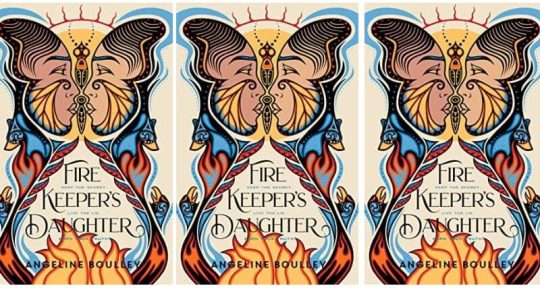
*As is usual with our discussions, there may be a few spoilers ahead, so beware.*
We all were incredibly excited to read Angeline Boulley's FIREKEEPER'S DAUGHTER when we first heard about it, so we decided to make it our second group discussion book for the year. Come join us!
As a biracial, unenrolled tribal member and the product of a scandal, eighteen-year-old Daunis Fontaine has never quite fit in, both in her hometown and on the nearby Ojibwe reservation. Daunis dreams of studying medicine, but when her family is struck by tragedy, she puts her future on hold to care for her fragile mother.
The only bright spot is meeting Jamie, the charming new recruit on her brother Levi’s hockey team. Yet even as Daunis falls for Jamie, certain details don’t add up and she senses the dashing hockey star is hiding something. Everything comes to light when Daunis witnesses a shocking murder, thrusting her into the heart of a criminal investigation.
Reluctantly, Daunis agrees to go undercover, but secretly pursues her own investigation, tracking down the criminals with her knowledge of chemistry and traditional medicine. But the deceptions—and deaths—keep piling up and soon the threat strikes too close to home.
Now, Daunis must learn what it means to be a strong Anishinaabe kwe (Ojibwe woman) and how far she'll go to protect her community, even if it tears apart the only world she’s ever known.
[Note: While we will not go into any great detail in this discussion, Firekeeper’s Daughter contains murder, suicide, kidnapping, sexual assault, addiction and drug use, racism, colorism, and death of parents/family members.
You can read an excerpt of the book here!]
Audrey: To get us started--let’s talk about this gorgeous cover! The cover art was created by Moses Lunham and designed by Rich Deas. The first thing I noticed when I got my copy of the book was that the two faces at the top had different skin tones. According to this interview, author Angeline Boulley says that “the different shades of the faces symbolizes Daunis claiming her biracial identity,” which is a major part of the book.
Jessica: The cover is so beautiful. It’s next to me on my desk right now and I can’t stop looking at it. Love how the cover ties into the themes of the book.
K. Imani: This cover is absolutely beautiful! I love the design of the faces looking like a butterfly as well as the bird and bear (I think) and the fire. There are so many subtle images in this cover that you can almost find something new each time. And the colors are so stunning. Like you Audrey, I noticed the faces had different skin tones which I found interesting and made me wonder what was going to happen in the book. Knowing the faces symbolize Daunis’s biracial identity now is powerful and really brings home the meaning of the book.
Crystal: I agree that the cover is gorgeous. In addition to the aspects of her physical appearance and physical identity, Daunis’ cultural identity is also displayed within the illustrations with bears representing her clan. In addition there are the birds like the one that guides her and the sun is in the background too which is from the story of the original Fire Keeper’s Daughter. The faces forming a butterfly is also just brilliant for a coming-of-age story. There’s so much to see. Each time I notice more.
Audrey: Daunis, our heroine, is on the older end of the YA protagonist spectrum at 18. She’s dealing with a lot of upheaval in her life, and things only get more complicated in short order. Something I really liked about Daunis was how often she thought about and evaluated what her responsibilities were--to her family, to her friends, to her community, and to herself. These sometimes complementary, sometimes competing, responsibilities strongly influenced her decisions.
Jessica: You mention the complementary and sometimes competing responsibilities -- that’s exactly it. I loved how her thought process was explored throughout the book in such a thorough and complex way. The way Daunis balances and reconciles the interests of her community with what the FBI wants from her and her quest for justice is laid out really clearly. Sometimes, narratives can tend toward simplistic, binary summations of the issues people, especially from marginalized communities, face -- but that’s just not the case, and Daunis really highlights that. To be honest, I was a little nervous at the introduction of law enforcement and the FBI, given the racism and oppression baked into these institutions, but the way Daunis navigates her interactions with them, plus the way other members of the community tell the truth about these institutions, really played out in such a nuanced way. (I really, really hope that the Netflix adaptation keeps these nuances and hard truths in the show, but I suspect that won’t be the case, unfortunately.)
K. Imani: I enjoyed that Daunis was 18 and on the cusp of adulthood. So many YA novels focus on the character’s high school life but a lot does happen and teens do grow and change a lot in that year after high school. Many have left home for college (that was me) or working full time and they are learning how to navigate a life that was not completely so structured. In addition to having to deal with changing friendships as people move away or just become busy. It’s a unique time and I loved that we got to spend time with Daunis as she was going through this change. She was learning how to become an adult in one of the most stressful ways possible, and sometimes I felt she was a little too idealistic, but I’m glad that she kept her truth throughout and was focused on helping her community in addition to helping the FBI. Her perspective helped keep the investigation grounded in what mattered which wouldn’t have happened if she wasn’t involved.
Crystal: Daunis balances a lot of responsibilities and really tries to follow what she’s learned from elders. She considers how her actions may affect all of her relatives within her family, clan, community, and beyond. Boulley embedded a lot of elder wisdom within Daunis’ inner dialogue such as thinking about the seventh generation when making decisions.
Audrey: One of the things that I really appreciated about Firekeeper’s Daughter was the depth of the setting and the characters in it. While Boulley says that Daunis’s tribe is fictionalized in the author note, it’s clear how much care and thought Boulley put into creating Daunis’s community. It’s filled with people who have complex histories (both within and between Native and non-Native groups), with differing opinions and prejudices and goals.
Jessica: This really highlights how important it is to have stories where cultures and communities aren’t portrayed as a monolith. It’s not just the right thing to do, it makes for a better and more accurate story. I read Firekeeper’s Daughter and watched the TV show Rutherford Falls back to back, which really drove home the power of depicting a community with nuance. (Also, sidebar: Highly recommend checking out Rutherford Falls, which does this really well.)
K. Imani: One of my favorite aspects of Firekeeper’s Daughter were the elders in Daunis’s tribe and how we got to hear many of their individual stories which showed the complexity of real life. I loved that Daunis listened to her elders, really took in their stories and learned from them. Her interactions with the elders greatly contributed to her growing sense of self and her desire to help her community. And this is where this novel being truly #ownvoices shines because of Boulley’s connection to her community that she took great care in making sure Daunis’s tribe felt real and authentic as well as culturally accurate. It was not full of stereotypes but filled with real people who had real lives and real stories. I was drawn into Daunis’s community and really cared about the people that made Daunis who she is and becomes.
Crystal: Like Jessica says, there is a lot of nuance here. When you have a wide variety of characters who are not simply good or bad, the story has more power and is definitely more believable. The people in our everyday lives are also complex and have a story if only we take the time to listen. This is what Daunis excels at with elders and others around her. She is paying attention and trying to connect with people. There is a lot of love throughout the book of many different types. The love is beautiful and yet also has some ugliness too in the betrayals. It’s not picture perfect and that makes it so much more real.
Audrey: Boulley tackles a lot of difficult topics in Firekeeper’s Daughter, especially ones that can hit hard on a community level. Much of the plot focuses on drug use and addiction, of course, but violence against Native women also has a significant impact on what happens in the book and affects multiple characters, including Daunis.
Crystal: Daunis and the other women are examples of the many, many, women who have been harmed in the past and the present. That’s not the whole story though. As Daunis is learning, there are many ways of being brave. Throughout the story, we see many women being strong and brave though at initial glance their actions may not seem to be either of those things. There is bravery in speaking out, but sometimes bravery requires something else. These women have done what they needed to do to survive or help their loved ones survive.
Audrey: Firekeeper’s Daughter has a complicated ending, and it left me thinking about two things. The first was how proud I was of Daunis and her character growth. There were a couple of times where she came across as very Not Like Other Girls (particularly with the hockey players’ girlfriends), but that changed over the course of the book. The second was grief at how many people and institutions failed Daunis and her community, both within and without. Just as one example, even though Daunis is a confidential informant for the FBI, the FBI doesn’t come out of this story as a Good Guy.
K. Imani: I was torn by the ending too. I so wanted justice for Daunis and Lily and for others who were murdered, but on the other hand life doesn’t always have a happy ending and I recognize that Boulley gave us that horribly realistic ending because the fight for missing and murdered Indigenous women continues and the fight for justice for Indigenous peoples. It was a heartbreaking reminder of a very real issue. On the other hand, I was so proud of Daunis as well. She was able to achieve her goals of helping out the FBI while staying true to herself and her community. She grew so much as a character and really found her place in her world.
Crystal: The ending gave me much to think about too. Daunis grew a lot as she worked through this complicated puzzle in her community. She learned much about herself and some of the assumptions folks have about others. I also really, really wanted justice, but unfortunately, would be unlikely in real life with our current justice system. I also found Jamie’s growth to be interesting. He is truly struggling with his own identity as an adopted child with Cherokee roots, but no Cherokee teachings or culture to turn to. I don’t know if a sequel or companion book is planned, but I would be interested in seeing more of their journeys whether their paths cross again or not.
Jessica: Audrey, thanks so much for leading this discussion! Now I have a question for you all -- what YA books by/about BIPOC are you reading right now?
For AAPI month, I’m rereading Turtle Under Ice by Juleah del Rosario. After that, I’m planning on reading The Ones We're Meant to Find by Joan He, Apple: Skin to the Core by Eric Gansworth, and Witches Steeped in Gold by Ciannon Smart! Yes, my TBR pile is excellent. :P
Audrey: Next up on my list are The Theft of Sunlight by Intisar Khanani, Forest of Stolen Girls by June Hur, and Simone Breaks All the Rules by Debbie Rigaud. I feel like that’s a pretty good mix of genres and authors right there!
K. Imani: Since I’m needing some inspiration for my vampire manuscript, I’m re-reading and new reading some vampire novels. Currently I am reading Fledgling by Octavia Butler then up next is Renee Ahdieh’s series The Beautiful and the sequel The Damned.
Crystal: I just re-read Saints & Misfits and then dove into the sequel Misfit in Love. S.K. Ali is an author that I really enjoy and I am loving it so far. Next up is American Betiya by Anuradha D. Rajurkar along with Love & Other Natural Disasters by Misa Sugiura. I also think my TBR is pretty stellar.
If you've had the chance to read FIREKEEPER'S DAUGHTER, please join in the discussion below! We'd love to hear what you think.
21 notes
·
View notes
Text
musical continuity and the Greetings (ごあいさつ) leitmotif
i wrote this 2 weeks ago I was originally going to make a post about the main motif first (y’all know the one) and then talk about Greetings later, but then 4.24 aired and,, well here we are
Greetings (the track) first shows up in 3.01 when Kageyama and Hinata display their quick before the Shiratorizawa match. It’s a badass introduction. It’s cool. The music is tied to this display of new ability, and it returns when Hinata saves Kageyama’s weak toss by hitting his left hand, winning them the set (3.06), as everyone is, again, introduced to something new.
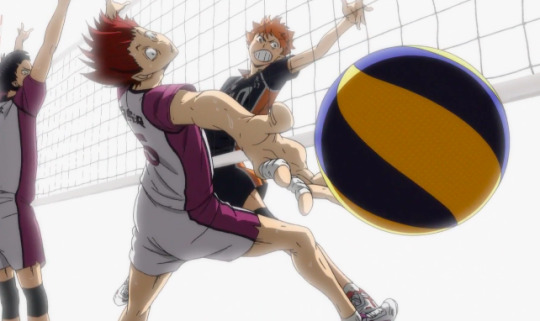
((this track might as well be called “someone does some cool shit for the first time and everyone loses their minds”))
All of this, what’s been previously set up, is subverted in 4.09. Kageyama hits a solid serve as we hear the build-up brass, then there’s Hinata’s run-up to spike. They’re both confident. We already associate Greetings with this triumphant entrance, proven three times before (the quick, the left-hand hit, and Tsukishima’s return in 3.08) — and so the music hammers home that expectation: Hinata is going to score the point.
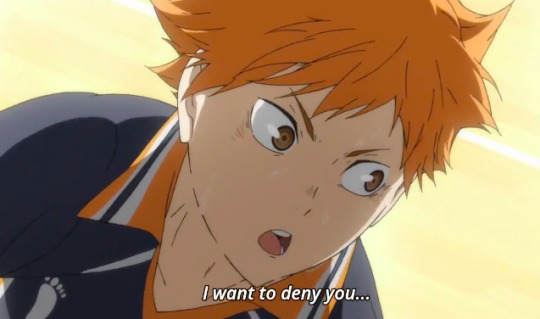
Except he doesn’t.
In this context, Hinata is denied the triumph of Greetings. As Shiratorizawa denies Hinata within the narrative, they’ve also co-opted the theme, denying Karasuno (and us) at a meta/music level. (ps I’m very sorry for using the words “meta-music”)
I think Greetings takes on a bit of a different meaning after this moment, especially because the next time it’s heard is when Hinata says “I’m glad I came here” in 4.12.
SO guess where we hear it in 4.24? Right after Asahi’s spike! Not during that big moment, but after, when Futakuchi’s explaining how Asahi practised and perfected the move. I saw this as a subtle change from its use in S3, because here it wasn’t Asahi adapting in the spur of the moment, it was the result of seasons worth of behind-the-scenes practice. The fact that Greetings plays over not the act, but the acknowledgement of it makes it not a “big” moment in terms of commentators/spectators going wild, but a big moment that’s testament to the team’s growth. As Daichi says, they don’t need a miracle, and as Tsukishima says at the end of the episode, the team isn’t surprised: because they’ve worked hard and trained.
Now here’s the other fun part. Technically, we hear Greetings a second time in 4.24. It’s a completely new track, but the Greetings leitmotif is unmistakable. It begins right here, with the first connection in the long volley:
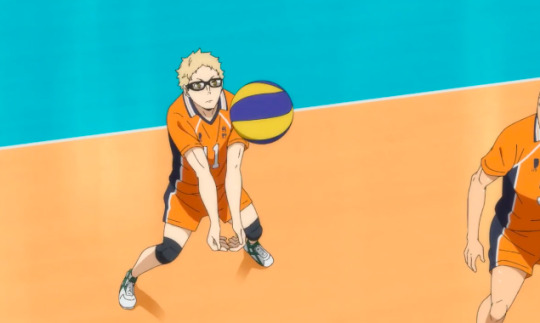
Just as in s3, the familiar melody comes in anticipation of triumph. But despite the familiar leitmotif, the instrumentation and tempo (overall tempo increases by at least 10 bpm) have changed. Something about it is off. This is felt even more because Greetings itself has already been used in this episode.
hear me out, Greetings goes like this:
starts with the french horn
then the melody is taken over by strings
you hear spiccato on low strings (those bouncing, short notes)
the electric guitar comes in to support them, before backing away
for the vocals to come in together with the strings.
The leitmotif in this new track begins with strings, so that’s recognisable, but the instrumentation of the second phrase is scored for trumpets. The trumpets are accompanied directly with this shot:
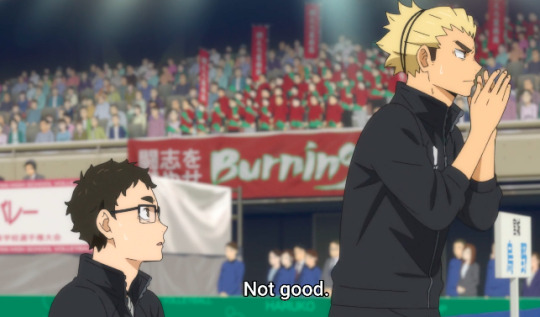
I really like the dissonance here, between the expectations the grand Greetings motif carries and Ukai’s worried expression. And as the characters’ pace picks up, the part which would have been the spiccato strings is no longer measured, but panicked and frenetic; the tempo is quicker than in Greetings, and now played by the electric guitar. The electric guitar, instead of having that give-and-take with the strings (in Greetings), fights with the strings and heavy percussion:
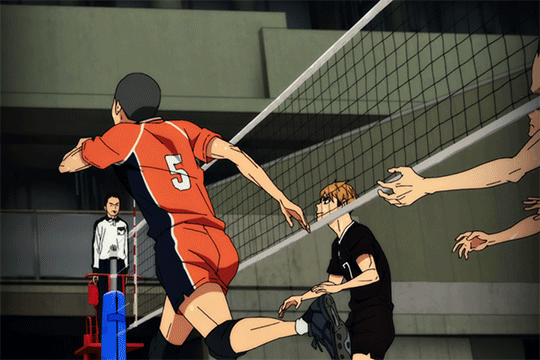
Eventually, instead of the choir vocals, arguably the most triumphant part that ends the track, the leitmotif melds into a completely new orchestration. At a musical level, the triumph is essentially slipping away from their grasp into unfamiliar melodic territory. Especially since this is the first time this leitmotif has been used outside of Greetings and i’m so here for it
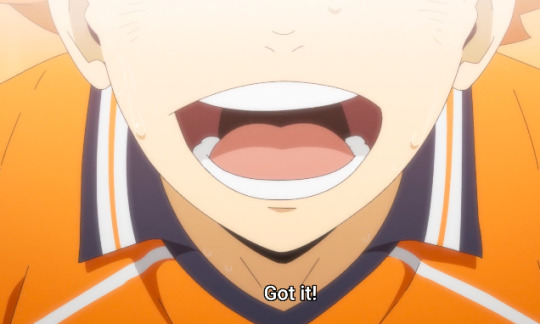
Then the music stops entirely. And even though the leitmotif cuts off, the circumstances end in triumph: Hinata saves it, almost as though he’s evolved past/overcome the music. And he does this with a simple receive, in a way that isn’t showy or immediately cool.
side note, I think it’s very interesting that Greetings is written in the same key as the main leitmotif. coincidence? i think not
I feel like very often, how scores are used is rather straightforward. Just look at any Marvel film: what you see hear is what you get. Emotional moment = slap some high strings on it. Battle scene = electric guitar/brass. Exposition scene = quiet, generic synth music that practically fades into the background. The music serves an entirely functional purpose: reflects the relevant emotions of that particular scene to fill in what would otherwise be awkward silence. It’s less a score and more just background music.
What makes a show’s score stand out (imo) is musical continuity. There’s awareness of the music in relation to not the moment in isolation, but the story. ((i’m just gonna plug les misérables, it’s done so well; take just one of many examples, with Valjean and Javert: narrative foils, each have an iconic solo with virtually identical music in What Have I Done vs. Javert’s Suicide.))
So as much as the music in hq!! slaps, I’m even more delighted that the score is actually being well-utilised. Don’t get me wrong, not everything has to have some huge narrative significance, and some track choices are probably just for fun (or maybe occasionally odd, but it doesn’t happen often), but for the most part, when it matters, it’s done right.
#i uhh. may or may not have transcribed the melody for this track#to compare to the main motif#which i will have to make a separate post for bc this is getting too long#local lit student never shuts up.txt#hinata shouyou#inarizaki#haikyuu to the top#hq!! meta#haikyuu meta#marc.txt#*mine#long post
24 notes
·
View notes
Text
[QZGS meta] what’s in an OP? dawning glory (pt 3)
(part 1) (part 2)
This is the third and last post in my little series analyzing the opening theme of The King’s Avatar Season 2! Honestly, this whole thing became way longer than I was expecting. I guess this is what happens when all my immense amount of love for this series, accumulated over years of no-donghua-updates, overlaps with my immense amount of love for anime openings.
Watched the first and second episodes yesterday, and they really sparked a lot of joy. :D I missed Blue River so much :D
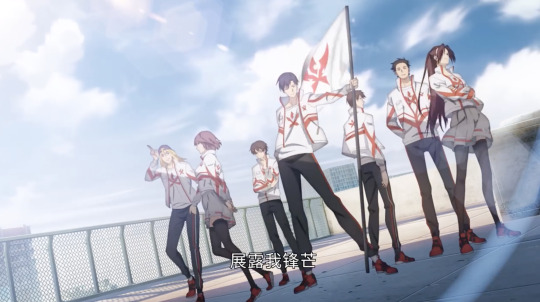
Yesterday, they released the OST for Season 2, which includes the TV cut and full versions of the OP and ED, as well as two insert songs, and the instrumental versions of all of the above. I’ve yet to find anywhere that lets me download the audio files (hoping they’ll be reuploaded to youtube or bilibili soon), but in the meantime you can listen here. They’re really good songs! https: //www. kuwo. cn/album_detail/15792659
Anyway, let’s finish up this OP analysis!
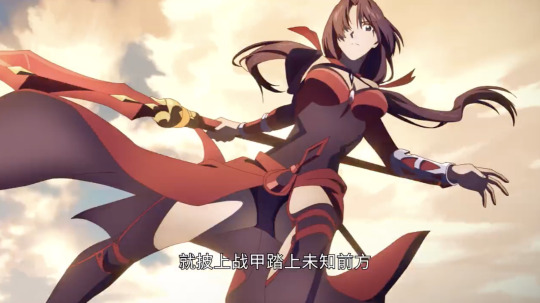
Now here, we reach the true climax as we enter the chorus section. This next segment is definitely the highest-energy part of the entire opening. It’s a montage of Happy’s characters showing off their moves, timed to the music; there’s not too much deeper meaning, but damn if it doesn’t look fantastic. The animation flows from one character and scene to the next so smoothly, so beautifully, it’s just incredibly hype to see. This is what you get when you specifically choreograph/animate sequences for the opening instead of just reusing shots from the main show! (Parts of some of these shots appeared in episode 1, but I do honestly think that it’s more likely that the show reused shots from the opening than the other way around, just because of how perfectly the OP fits together. I also don’t think it’s super noticeable in-show; I’ve just been watching this obsessively.)






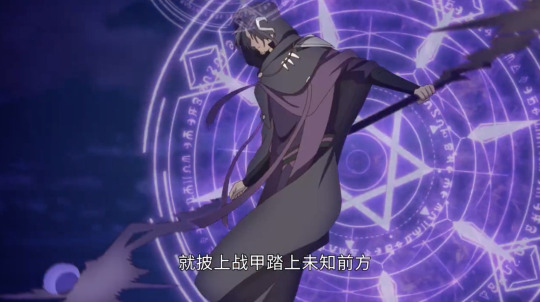
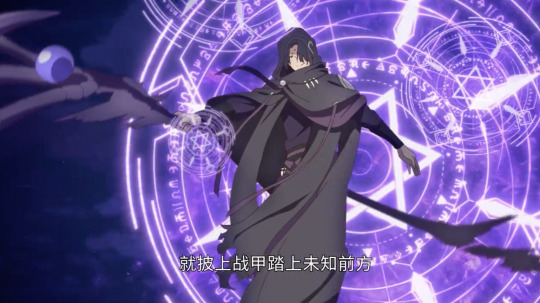
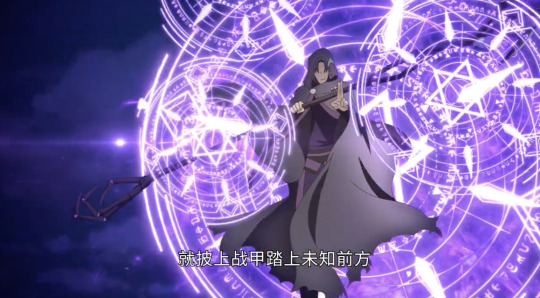
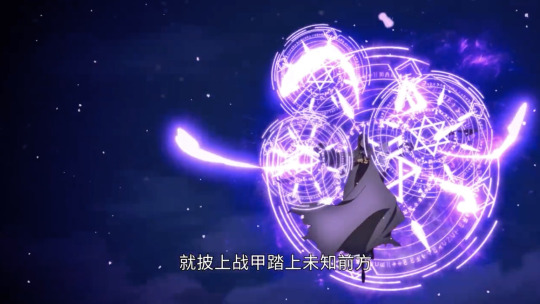
In particular I love the line that kicks this all off: “just put on your battle armor and step onto the road to the unknown.” Specifically, though, the rhythm of the lyric is, “jiu pi shang zhan jia ta shang wei zhi qian fang,” with emphasizing accents on the -ang sounds. This isn’t how you would divide the phrase naturally, but because the (syncopated!!) melody accents these notes/syllables, the rhyming effect really stands out and it feels as clever and satisfying as a rap lyric. Moreover, the emphasis times juuust right with the attacks of Soft Mist, Steamed Bun Invasion, and Windward Formation, a perfect example of how music and visuals mutually reinforce each other for maximum cool effect.
It’s generally easier to rhyme in Chinese than English, because of a smaller phonetic vocabulary. From the chorus onward, the key rhyme is on the “-ang” sound (think “ahng” or “ong”, not “aang” like the Avatar), which is a good choice - powerful, reverberant. The asymmetry of the syllable’s use in this section - the song’s lines are all different lengths at this part, so you’re kept on your toes as to when the pattern will reappear - helps add to the engaging excitement of the song. This is also the syllable used for most of the rhymes in the second half of the first OP.
jiu pi shang zhan jia ta shang wei zhi qian fang
hui qi shou zhong wo jin de na shu guang
you ni men zai lu shang__
shi li liang



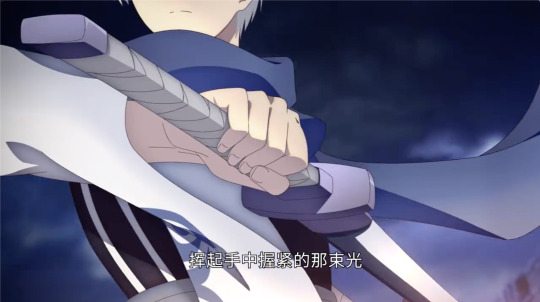
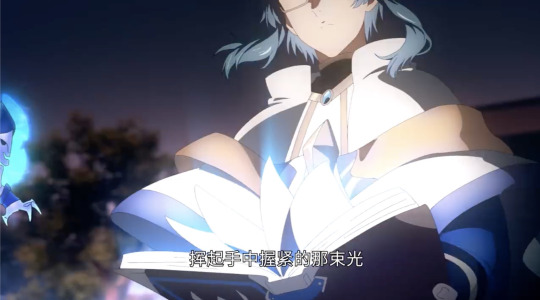
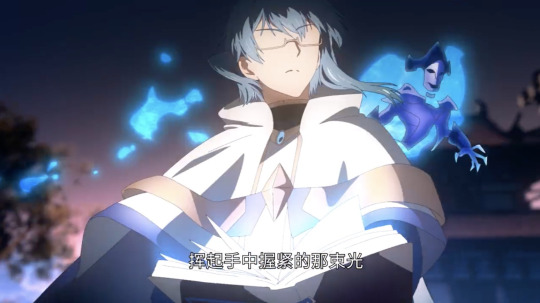
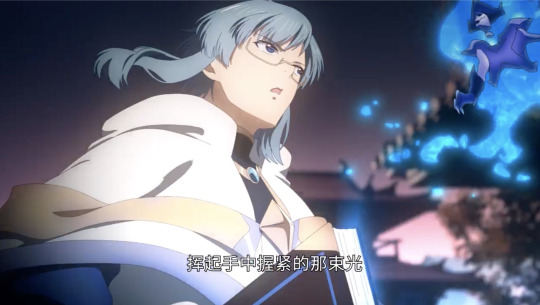
I really love One Inch Ash’s design. Concealed Light had a big redesign for this season, and honestly I like it as well. And notice here that he’s holding a book - exactly how we left Luo Ji when we saw him last!
“Waving the light clenched tightly in our hand” - that is to say, brandishing our light as our weapon, no matter what form it may take - a sword, a book, our hope and determination.
On a purely musical note (ha), right at this point, specifically the measure beginning with “那束光,” you can hear a three-note “ooo” harmony line in the background, and wow it’s so subtle but I love it so much! A similar three-note line actually appears earlier too (during the “crossing the frozen finish line,” right as the music is building up), also to great effect.

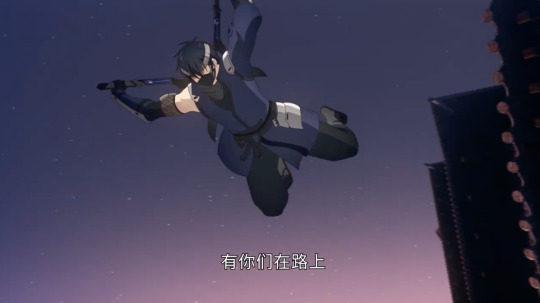
We follow Concealed Light’s gaze upward to the building to see Deception running along the wall, from which he does a flip and slashes downward with twin blades. I love that transition a lot, but my favorite transition of this entire sequence has to be the following one:


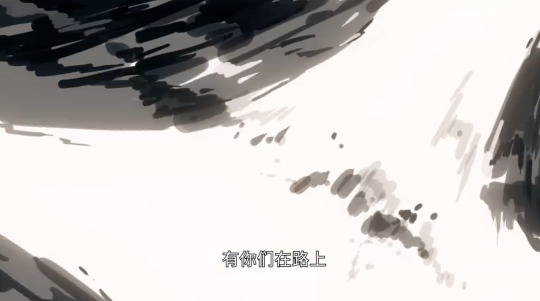

Yes! Deception’s cross slash resolves perfectly into the cross held by Little Cold Hands. It’s so fast and so natural you don’t even notice it, and that’s the absolute beauty of it. The first time I saw this, I was in awe - the animators really brought their A-game to this, far better than I ever would have dared hope for this series.

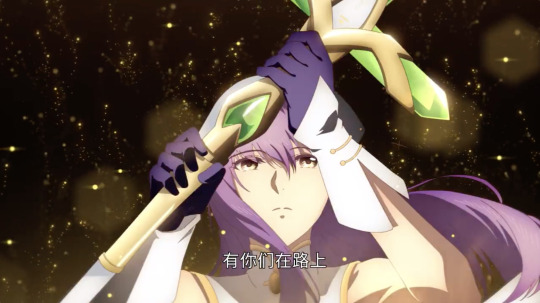

And Little Cold Hands is so pretty! When we got our first art of her official design, the comments were filled with people simping for her, and honestly, valid. I’m surprised her hair is purple instead of pink, but that’s just a minor thing.
There’s something especially powerful about how she raises her cross in time with the lyric “having you all here [with me] on this road,” and then the cross flashing brilliantly with “it’s power.” More than any other role, the healer is a team player. And this theme of team togetherness is particularly important for An Wenyi, who is deeply moved by the team’s perhaps illogical faith in him. Remember that analogy Ye Xiu tells him, of the straw tied to the deluxe mitten crab?
An aside: listening to this, I always thought the line should be 有你们在身旁 instead of 有你们在路上, because it still fits the rhyme, because my past experience has somewhat conditioned me to expect that phrase, and because the full message of “having you by my side is power” just makes me wanna tear up like what a good line! So it felt like a missed opportunity that they didn’t use that. But as it turns out, the final iteration of this chorus in the full version of the OP does, in fact, use “by my side”! And I think making this tiny tweak to the lyric the final time you here it just makes it that much stronger :’)
I’m also just a big fan of the “it’s power” melodic flourish in general, since it comes as a surprise. You kind of expect the melody to end with the previous phrase, but the extra notes here add a really nice emphatic beat to finish off the line.
So to recap the transitions: we see Soft Mist falling from the sky and get a close up of her face as she stabs her spear; this takes us to a closeup of Steamed Bun’s face facing roughly the same direction before we zoom out to his torso and he slashes from lower left of the screen to upper right; following the motion of that slash we see Windward Formation’s torso rotate in that direction as the camera zooms out farther; we follow the rays of his attack to see One Inch Ash drawing his sword; we zoom in on the flashing blade and zoom out on Concealed Light’s glowing book; we follow his gaze upward to see Deception running along the building behind him; Deception leaps and slashes and the slash becomes Little Cold Hands’ cross, which raises up and triggers an explosion. It’s just so dynamic and smooth even without taking place in one continuous setting, and it just really, really gets you hyped.
Also, starting from Happy’s team picture at the start of the chorus, which is during the day, it feels like Soft Mist and Steamed Bun’s moves are at late afternoon, Windward Formation and One Inch Ash take us to nighttime, and then you can see the first rays of morning in Concealed Light and Deception’s segments. This continuity also definitely helps with the feeling of natural flow through these scenes.
Anyway, this entire action segment is just so beautiful, I could watch it on loop. But we still have the final segment of this OP to analyze, so let’s keep going.

After the action sequences of the climax, we settle down a bit now as we approach the end. Here we see the Excellent Era team picture, in the same style as the team pics we saw earlier, but presented separately. It makes sense, as the role they play in the story is different from the roles of all the other teams.
Sun Xiang, Liu Hao, and Cui Li are at the bottom. Because we’re panning up, these three are the first we see. At first glance, the way they’re positioned is fairly consistent with the team pics we’ve seen already: Captain Sun Xiang at center-right, the largest figure; vice-captain Liu Hao, manager Cui Li in the background.
Sun Xiang’s position and expression is really the only one that fits the healthy pattern of the teams we’ve seen already - looking toward the camera, a confident (though arrogant) smile. He might be misguided, but there’s hope for him yet. Notice how Liu Hao isn’t even looking at the camera, which as we’ve seen before is somewhat of an indication of how unified and focused the team is toward its goal; instead, Liu Hao is doing his own thing, determined to prioritize his own desires over what’s best for the team. And manager Cui Li is in this image too, despite not even being a player. His sinister presence reflects the unhealthy interference of the business side in the gaming side. Excellent Era’s downfall comes about because of its prioritization of profit over victory.

As we pan up, Excellent Era’s logo comes into view. It’s larger than any of the other team logos we’ve seen so far, spanning around three-quarters of the screen whereas the others looked to span no more than half. Excellent Era’s legacy is a weighty one, to date the only team to have ever won three championships, and consecutively to boot.
It’s this immense, shining logo that seems to be casting Tao Xuan on the left into shadow. He cuts a large figure, reflecting the deep impact his actions have had upon the main plot of this story, even though he’s only now appearing for the first time in the donghua.
However, he’s also turned away from the camera, such that we can barely even see his closed eye. Because of that, it’s difficult to read his expression, but the impression given by this pose is not one of vindictive pride, but one of shame, as though he can’t quite bear to face what he’s done. On some level, no matter how he might try to rationalize it as necessary, Tao Xuan knows that his profit-driven betrayal of Ye Xiu was a pretty awful thing to do. It might be this amount of guilt that leads him to offer Ye Xiu a wish granted, a tribute to their years of friendship and partnership before their ties are severed completely.
In the end, Tao Xuan’s greed leaves him with nothing really to show for it. What had he gained? What had he lost? Those realizations are still a ways off in the story, but I like how this OP is already hinting at the depth of his character. Tao Xuan isn’t some glasses-flashing, evil-laughing, one-dimensional antagonist; he is in fact very realistic for the setting. We can condemn his actions and priorities, but at the same time we can understand how he ended up here.
As for Su Mucheng, her eyes are closed as well. She’s brightly illuminated, but pointedly turned away from all of the others in Excellent Era; she knows the direction of her future, and that it no longer lies with Excellent Era. Her loyalty was always to Ye Xiu, and as soon as he was banished, her relationship to the team was professional and nothing more.
“This light hidden in my heart is burning” - there are many ways to read this lyric and what exactly the light referenced here is, but because the line is paired with this image, I naturally think about Su Mucheng’s situation. Despite her pretty-vase, sweet-girl appearance, she holds a deep, profound anger at everything that happened regarding Excellent Era. It’s a testament to her immense strength of character that she lasted the remaining one and a half years of her contract in this hostile environment.
Yet even as she resolves to cut ties, there’s a sadness in her expression. She was here from the very beginning as well, when Excellent Era was no more than an internet cafe, and it pains her immensely that the powerhouse, championship team that they and her brother had built from the ground up would ultimately meet this tragic end.
It’s interesting to note that both of the “redeemable” characters here (namely Su Mucheng and Sun Xiang) are on the right, more brightly-lit side of the screen, so there’s a nice little dividing line you can draw there. Sun Xiang’s eyes are still looking toward the left, though, revealing how his character development still has yet to play out.

From there we cut to Ye Xiu holding Lord Grim’s account card. He’s standing back on top of the roof from the beginning of the OP, now in full daylight.
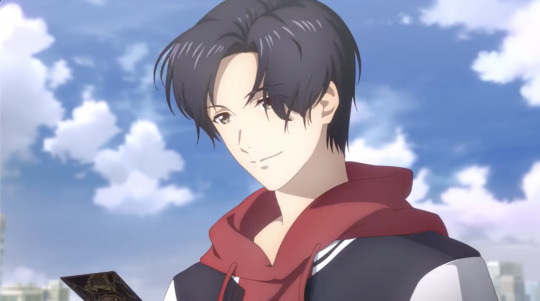


As mentioned… the animators really went ham on the bangs animation.
Ye Xiu turns away from the railing, the camera cuts to an image of Happy’s logo on a flag waving in the wind, and then we zoom out to see the current members of Team Happy gathered together in uniform, standing proud in the light of day. Left to right, Steamed Bun, Tang Rou, Luo Ji, Ye Xiu, An Wenyi, Wei Chen, Chen Guo. Presumably, this will be Happy’s lineup by the end of the season.
Up until now, we’ve only seen the real players separate from each other - they’ve all been in different places, never even in the same frame together. (This, of course, also contrasts the pro team pics that we have, which show everyone together.) Halfway through the OP, we got the group shot of them meeting in game with their characters. And now, they’ve finally met up in the real world as well.
One thing I like about this final pose is how it compares to the final pose of the OVA OP. It’s the same kind of power-pose vibe, but there we only had Ye Xiu, Chen Guo, and Tang Rou. Look at how we’ve grown since then! They’re well on their way to being a proper pro team!
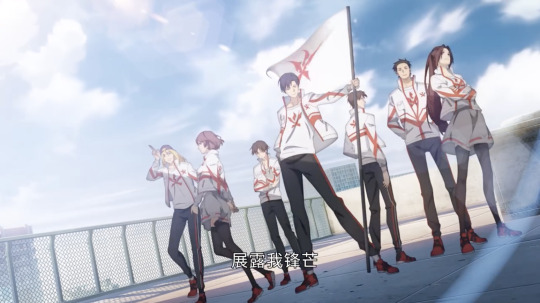
And that’s a wrap! With this final image of Team Happy gathered together, we’re ready to enter the episode proper.
So let’s talk about the OP as a whole. Generally, an OP serves a couple of main roles: a) tells you a bit about what the show is about, b) gives you an overall feeling / mood for the show, c) gets you hyped and ready to watch the upcoming episode.
How well does this opening achieve those goals? Pretty well, as we’ve seen. Past OPs did a pretty good job of setting the mood, but they honestly just put some pretty visuals on the screen, only vaguely aligned to the music, and called it a day. This OP, however, has a cohesive storyline to tell, framed around Team Happy’s coming together (following the tagline of this season). Even in such a short span of time, it manages to convey so much information about its story and characters, both overt and implicit (as I hope this series of posts has managed to convince you). Paired with the music, which has its own deeper meanings encoded in the lyrics, the OP becomes incredibly effective and memorable as it makes its statement.
I mentioned an “interest curve” earlier (interest in the sense of interesting, not the money); this is part of the standard formula for anime opening songs, in my experience. I’m a little too lazy to draw a graph myself, so take a look at this image:

(source: https: //www. researchgate. net/figure/Example-of-an-interest-curve-for-a-successful-entertainment-experience_fig1_333917625 )
Although not all of the relative heights and segment lengths are accurate in this specific case, hopefully the general shape of the interest curve is enough to demonstrate my point. You’ve got the A-B peak at the opening instrumental segment, the C-D peak/arc over verse 1, the D-E-F peak/arc over verse 2, then the sharp F-G-H peak over the chorus before dropping off for a smooth landing right into the episode. This general pattern is effective at holding the viewer’s focus and managing their excitement over the course of this one and a half minutes.
Visually, the OP is just such a treat for the eyes. I’ve already talked about many of the little details I love - lighting, character designs, animations, transitions, etc. - but all in all the new animation studio is doing a really good job here. An OP is how you hook people, and I’d definitely feel comfortable using this to try and bait people into watching this show.
One comment I want to add is about the incorporation of the credits, which we didn’t see until the episode premiere. I don’t think there’s anything too exciting to say (and I also don’t have access to any images right now since the OP was only shown in episode 2), but the fonts and styling were a nice choice - it gave a gaming vibe, but if I recall it still used a serif font, so it didn’t feel overly modern - and the text positioning generally complements instead of distracting. I also liked how they showed the lyrics! I didn’t really expect them to include them onscreen, or if they did, I thought they would just be plain subs like they were in this video. But in the actual OP that plays at the beginning of the episode, they’re as much a part of the art as the credits!
If I had to make any criticism, my biggest complaint about the OP is, I think, the singers. I think having two different singers trade off can work nicely, but in this case, the switches are jarring because their voices are so different. The first singer has a lower, gravely voice, while the second singer’s voice sounds much brighter and more nasally. Furthermore, the first switch doesn’t come until we’re fully halfway through the song, which means that by that point we’re already used to this first singer. It’s also strange that they’d switch back to the first voice at the climax of the song, when I think the second voice would suit the high-energy segment much better. Switching from second to first right at this point feels like we’re actually taking a step down in energy, which is the opposite of what should be happening here.
Still, my main problem isn’t with the voice switching but with the voices themselves, and I think the voices are something I could get used to. The third switch, going from the first voice back to the second voice during the shot of Excellent Era, is much less jarring than the others - I actually like how it feels like the solo is passing naturally from one person to the next, emphasizing the ideals of this not being a single-player game and all that. For that transition in particular, I think (because of the added “it’s power” flourish) it happens too quickly for one person to sing it comfortably, so having another person pick up the line works best. And I do like how the voices sound when they overlay together for the final lines of the song.
So, overall? Overall, this OP is really damn good. It’s everything I could have asked for and more. After such a long wait, the OP, at least, does not disappoint, and I’m extremely excited to see what the series has in store for us.
If you’ve read to this point, thank you! I like this series a lot, as you can probably see, and I’m treating it as my glory :)
18 notes
·
View notes
Photo
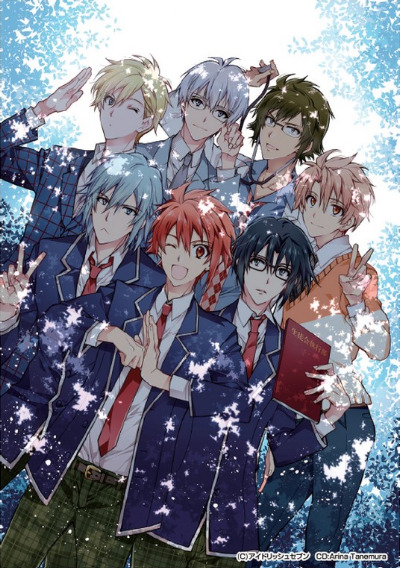
Excerpt: Novel IDOLiSH7 Ainana Academy
Novel: Sasaki Teiko
Character Draft/Illustrator: Tanemura Arina
Original Work: Bandai Namco Online
(C) IDOLiSH7
In the darkness, a phantom flower bloomed.
It was a digital art flower projected on a jet black wall as if ink was painted on it. In a space where there was nothing, a speck of emerald green light suddenly flashed. Shining young buds quickly spread, leaves flourished, and at the tips, seven flower buds--fleeting like the moonlight--grew.
As the flower buds grew, each took on a different color and soft flower petals gently unraveled.
Here was the recording studio of a web-distributed program.
The ones filming were the members of the budding idol group, IDOLiSH7.
It was the recording of the final episode of the mini drama "Ainana Academy".
"Ainana Academy" was a drama in which Yamato, who planned to control the school, joined with Sougo and Iori to confront Nagi, Riku, and Tamaki.
Bright lights were lit simultaneously. The camera crew was on standby.
At the cue to start shooting, against a background of faintly lit digital art flowers, Nanase Riku, dressed as a cheerleader in a white chouran with the sleeves tied with a red ribbon, raised his voice.
"I hate the darkness! I hate your darkness! That's why with the power of love, I will burn away all your hatred! I will not forgive you--"
A gentle and honest voice resounded throughout the studio.
At that moment, a warm and pleasant atmosphere spread all through the studio.
No fragments of hatred could be felt from the way Riku crisply shouted, nor his direct gaze. Instead, Riku was making puppy dog eyes.
Confronting Riku was Ousaka Sougo, who was wearing a cape like a vampire, and Nikaidou Yamato, playing a doctor in a white coat, whose face relaxed.
"...Sorry, Riku. I don't really feel hated by you. It feels like I'm actually being forgiven,"
Told Yamato, who was fiddling with the stethoscope hanging around his neck.
"Um."
"If you say it with more contempt, onii-san might feel it."
"Uh...um."
Yotsuba Tamaki, who was waiting behind Riku, snorted.
Riku stared at Tamaki who just made fun of him. Tamaki, a current high school student, looked really good wearing a uniform casually and stylishly.
He looked back at Riku and as if a switch was flicked, Tamaki began roaring with laughter.
Standing to the side, Izumi Iori made a face like he swallowed a bug. Iori was properly wearing a uniform buttoned all the way to the top, with glasses as accessories. Iori pushed up the bridge of the glasses with his fingertips, and sighed heavily.
However, the director could not be heard saying "cut." In other words, filming continued.
"I-I will not forgive you!!"
Quickly turning towards Yamato and Sougo, Riku said his lines once more, for good measure.
Right in the middle between Riku and Yamato, Izumi Mitsuki who was tied up and sitting with an apron on, looked over Riku with a nervous expression. Next to him was Rokuya Nagi, holding a glow stick and wearing a happi. Nagi crouched down, untied Mitsuki, and stood up.
"OH! Riku. Hatred doesn't suit us. Even if your partner is the leader of darkness. When our weapon is ready, you'll feel not hatred, but love. So, Riku--"
Nagi informed with a smile. Hair of gold and eyes of blue. Anyone would be fascinated by the beauty of Nagi, who came from a small country in Northern Europe.
"Let us sing."
"What?! A song?!"
Riku batted his big eyes.
"Yes. Because we are IDOLiSH7. Come on, music!!"
Nagi snapped his fingers.
Music began playing.
While they were acting out the mini drama, in the background, a paradise of digital art flowers started playing, each bud blooming.
"...I didn't hear anything. About this."
Riku opened his mouth flabbergastingly. It seemed that not only Riku but the other members besides Nagi didn't know to sing there.
Mitsuki was the first one to suddenly run off. He raised his hand in front of the camera,
"Does each person have a mic?"
And signaled to the staff. The members each picked up the mics prepared by the staff.
They automatically settled into their positions.
The intro ended, and Riku's singing voice resonated in the mic. His overwhelming singing ability and rich singing voice enveloped the entire studio.
At first there was a bit of confusion, but once Riku began to sing, everything was clear.
A sparkling singing voice that would drive away the darkness burst out, and Nagi said, "Good job," and gave a thumbs up with a smile, and took his turn.
While Sougo waved his jet black cloak, he made a careful step.
Mitsuki's petite body jumped according to the music, exciting the staff.
Tamaki's dynamic dancing drew everyone's gaze.
Yamato looked at Tamaki's dancing, and showed a daring smile.
The appearance of Yamato, who was twirling the stethoscope while casually singing, immediately conveyed that, "Come to think of it, this is a scene from a mini drama."
He made a gesture like he was acting in a play, and while singing and dancing, Yamato’s presence overpowered Riku and Nagi. Iori immediately reacted to Yamato's acting, and he forced his way in front of Yamato to support Riku. Yamato was instantly impressed with the ad-lib and smiled faintly.
The director's "cut" still could not be heard.
The studio was dyed in IDOLiSH7's color.
IDOLiSH7 was asked to appear on a web-distributed program two months ago.
The first member who heard about this was Iori, who heard it from Takanashi Tsumugi--a manager belonging to the talent agency, Takanashi Production.
Although Iori was an idol, he had confidence in his analytical ability, and assisted Tsumugi a lot. However, that Iori took on the role of Tsumugi's brain was a secret to everyone. There was fear as a current high school student, whether other members might show resistance to the youngest among IDOLiSH7 leading the group.
"A web-distributed program...?"
"Yes."
As idols, IDOLiSH7 was a bud that just sprouted. With hidden sparkling and shining energy, they are absolutely "real idols", but they're still rather unknown to the general public.
As for the reason they haven't made their break yet, it was obvious to Iori. They had too little exposure.
If you listened to their songs and saw their dancing, you would become a fan. That was the only ability and charm they held. However, there were almost no TV programs that invited the rookie idols IDOLiSH7.
During this time, an offer arrived at the agency for a variety program that would be distributed online, rather than on TV.
"That's right. I think it may be good to try this,"
Iori said, checking the terms of the request. However, Tsumugi made a surprised face.
"Eh? Really? But before, didn't you say you had a concern about doing online programs?"
While Iori discussed IDOLiSH7's future development with Tsumugi, she recalled what he formerly expressed.
"Yes. I said that. We are an idol group that attracted attention from online videos. The assumption that we are familiar with online distribution is correct. But..."
Because of an accident, IDOLiSH7 had to sing outdoors during a storm, and a video of that went viral and drew them a lot of attention.
Idols of the Internet age. The video circulated among people who liked and favorited it on social media. Spread without corporate promotion, the radiance of a new and fresh group called IDOLiSH7. That was one of our weapons, Iori thought.
But at the same time, he understood that this precarious position was a double-edged sword.
"On the other hand, if we rely too much on online distribution, there's a possibility we may develop an unwanted reputation. If I may say this freely--I don't want us to become 'cheap idols.'"
"Cheap...idols...?"
"Yes. It's a really subtle balance...but with one misstep, cheap idols will fail. Now is an era where anyone can post online. Amateurs can get popular by posting videos online, and they collaborate with companies to make videos. In that context, we must think of what it means to be professional idols. It isn't just about increasing exposure."
Tsumugi listened with a despondent face. Although Iori wasn't mad about Tsumugi's management, he sometimes caused her to make this kind of face. Her chest hurt a little.
"But...I think it's fine!! IDOLiSH7's singing and dancing are not cheap. You're the real deal. You're true idols. I know for a fact. I believe when people see you, they'll definitely understand!"
Tsumugi looked discouraged, but as soon as she bit her lip and took a deep breath, and her big eyes moistened, she turned to Iori and declared this.
Iori, taken aback, gulped. Because she said this with a puppy dog face without calculation--manager is scary.
"Of course,"
He replied immediately. Because Iori himself "knew" that IDOLiSH7 was the real deal.
The idol group that ran before them--TRIGGER--wasn't strong in variety.
Therefore, it was a good strategy to target the areas in which TRIGGER was weak.
Also--.
"This time, the web-distributed program seems to have a tight budget at this stage, so we need to tackle the project sharply. As for the film editor, a freelancer is better than a well-known one, but..."
He looked over the proposal, and checked the names of the staff along with the plan.
Before, Iori saw one of the names of the people involved with the filming in an interview online.
The name came up in a question about "interesting people lately" in the globally active, up-and-coming digital art group, Y-Classic.
He was a student who attracted attention in the art world for the stylish video he created as a hobby, which spread by word of mouth and became famous.
"I watched the video he made. In addition to his skill, his excellent way of showing the theme, the beautiful imagery, the quick tempo, and how it made you laugh, was understandably popular. If we find that kind of fresh talent and attract him to our program--isn't it okay to entrust ourselves to him?
Tsumugi stared in wonder and muttered, "I didn't know. There was someone like that in the staff."
"Our greatest weapon is Nanase-san's singing. If they hear our singing and see our dancing, the viewers will definitely understand that we are the real deal. Finally, if we make a corner showing our singing and dancing, along with the main point of the proposal, the mini drama ‘Ainana Academy’, I think the staff will surely challenge it and make something interesting. This job seems worthwhile."
"Understood. Then, I'll take accept this job!!"
Tsumugi responded energetically.
Five days later, the script for the drama arrived at the agency. A job for all the members of IDOLiSH7.
Within the group, MEZZO" already formed as a two-person unit, and Tamaki and Sougo had their CD debut, so their workload would further increase. Their responsibilities would grow, but even so, the two in MEZZO" were overjoyed.
In the first place, Tamaki and Sougo didn't have the slightest intention of only doing MEZZO". Rather, for the sake of debuting with IDOLiSH7 as seven people, they had been working hard to cut through as the advance guard, and clear a path.
It wasn't lip service; they were seriously acting with those intentions. Therefore, when the manager wanted to focus on IDOLiSH7's management and business, MEZZO" had a lot of work where it was just them alone.
At a small and weak agency, idols were being produced. They couldn't buy a car for exclusive use yet, so the two people in MEZZO" moved around by train. For the time being, they hid their faces with sunglasses and hats, and moved with their idol switch off. Even so, people who notice will notice, but they haven't yet experienced someone overbearingly talking to them and causing a racket.
However, Tamaki was disappointed in hearing "there's still quite a ways."
Tamaki stepped into the highly exposed entertainment world because he wanted to find his missing little sister. He had not revealed this reason to others yet, but he thought he always wanted to be more famous. He wanted to appear on TV a lot more. It would be good if his sister saw his existence.
Tamaki had his head in the clouds while he was riding the train with Sougo. They were sitting next to each other on an uncrowded seat. To the public, MEZZO" got along very well, but the truth was entirely different.
"Tamaki-kun, did you properly read the script?"
Sougo took the script out of his bag, and began reading it. It was also Sougo who put effort into remembering their travel times. He was serious. He was the type of person who thought what you ought to do today, you should accomplish today. It didn’t mean he was not serious. He always kept his eyes on the ball, which was why he was now only thinking of their next job.
"I'll do it later,"
He brusquely responded. Sougo slightly lowered the corners of his eyes.
It was unknown how many times it had been repeated.
The two have had similar back-and-forths many times.
Sougo looks very kind, and spoke with a gentle tone. With an atmosphere like warm spring sunshine, Sougo was basically always gentle and kind.
However--sometimes Sougo gave instructive guidance to only Tamaki. Tamaki was displeased with this.
"Since it's a job for the seven of us, we must do our best. We discussed this when the job came in earlier. The recording is the day after tomorrow. If we filmed separately, it would look unnatural, so we're doing it on a day when everyone can gather together."
It always felt like this. Sougo just gave Tamaki a lecture.
"Okay."
"To match our schedules, the staff hurriedly booked a studio. Everyone suddenly had to memorize their lines, and they were even individually practicing in the dorm."
"Soo-chan, did Mikkii tell you to be so loud?"
It was a mini drama about a school. Sougo was cast as a hot-blooded teacher.
Sougo was worried about how to act hot-blooded, so he consulted Mitsuki about various things. According to Mitsuki's advice, Sougo tried waking up the sleeping Yamato with a loud voice and took him along running, loudly interrupted Nagi who was proclaiming his love for ‘Magical Girl★Magical Kokona’, confirmed the schedule, and earnestly asked, "For the next job I want to raise my level of enthusiasm, so please watch ‘Magi★Kona’ with me. I will use it as a reference." Even if Nagi wasn't asked, he was always devoted to spreading the word of "Kokona's splendor". When Nagi realized, he had Sougo sitting in seiza in front of him while reciting "Kokona Love", while Sougo nodded with a serious expression vowing to "study a lot".
"What was that, practice?"
Sougo nodded with a troubled face at being seriously asked this..
"It was practice."
"It was noisy."
"...."
"Last night, Soo-chan was so loud, I lost motivation."
Sougo, deeply serious about "creating a hot-blooded role", approached Mitsuki for a consultation. At Mitsuki's advice, he gently laughed, said "I'll try," and straightened his posture. Afterwards was a rare scene of Sougo loudly waking up Yamato.
Sougo boldly challenged Yamato who easily brushes those things aside, and yelled from the pit of his stomach. Sougo did not usually raise his voice like this.
Yamato dodged with a, "Sou, are you drunk? Don't run around, sleep next to onii-san," and it ended in failure.
Mitsuki laughed at Sougo's failure and said, "Don't mind." Sougo replied "yes" with a serious look on his face. Riku, Nagi, and even Iori surrounded Sougo and let out a laugh at the gap between the endeavoring Sougo and the everyday Sougo,
At everyone's smiling faces, Sougo said, "Being hot-blooded is tough," and showed a bashful smile.
However, Tamaki could not laugh.
The inside of his chest felt prickly and unpleasant and hurt a bit.
When Sougo was around people other than Tamaki, he always gently laughed like a flower swaying in the spring wind. He did not get mad at anything Mitsuki said, and acted earnestly in accordance with Mitsuki's suggestions.
Sougo did not consult Tamaki, among other things. He did not rely on Tamaki.
Even though he knew he was unreliable, Tamaki still did not like it.
"Is that so. Sorry. So that I don't bother you, Tamaki-kun, I'll quietly practice in my room starting tonight,"
Sougo said with a troubled face.
He was bewildered by the apology. However, that wasn't it, thought Tamaki. Tamaki didn't want Sougo to apologize to him. But he also didn't intend to complain.
Even though he didn't say it was a nuisance--.
Did he mean to sound that way?
Sougo was good at extracting unpleasant words from Tamaki.
Tamaki got depressed at telling him to throw away his blunt words.
Sougo also got depressed being told that.
The two in MEZZO" were not good friends in the slightest.
Once again, the inside of Tamaki's chest prickled.
Sougo hid away the beaming smile he showed everyone from Tamaki, and the shutter in his heart made a loud sound and fell with a clatter. He pushed aside the feeling of "Today's smiles are out of stock. The store is closing now."
Sougo began reading the script fervently. Tamaki still felt like he wanted to say something, but he was irritated and without saying anything, he firmly pulled down the brim of his hat and closed his eyes.
So then, the recording of the web-distributed program started.
In the studio, each person was reading the script which was prior distributed, and Yamato who was wearing a costume, asked Riku,
"As I thought, isn't this look tight for onii-san? Wearing a high school uniform after all this time at the age 22 feels too much like a punishment."
One corner of the program was a mini drama--"Ainana Academy".
Somehow, Yamato was forced to wear a high school uniform. He wore a navy blazer, red necktie, and white button-up shirt.
"The size seems right. Yamato-san, it's a perfect fit. Where is it tight?"
Riku answered Yamato with a straight face, and looked over Yamato's school uniform from the front to the back.
Yamato didn't know what expression to make at being thoroughly examined, and looked to the sky.
Riku spontaneously burst out. Even if he explained his reason to Riku, he would not understand. Yamato pushed his glasses up and muttered.
"Mitsu, Sou, and even Nagi get to play teachers, so why am I playing a student..."
"Ah, I also thought something was strange. I wonder why I'm playing the youngest character. It feels weird that Iori and Tamaki are playing my senpais."
Yamato tilted his neck at Riku who was wearing the same school uniform.
"Oh. Rikkun is my kouhai?"
Tamaki, who was wearing a school uniform, asked Riku with the sense that he "just found out."
"Yeah. That's right."
"Oh."
"Yotsuba-san, incidentally I'm playing your classmate,"
Iori confirmed with Tamaki.
"Really? Okay."
Iori was also in a school uniform. He wore an armband that said "Student President" on his sleeve, and blackish green glasses. They were the type of frames that would look uncool depending on the person who wore them, but they fit Iori's fresh and neat look very well.
"Tamaki-kun.... You read the script properly?"
Sougo heard the conversation, and asked Tamaki worriedly.
Sougo wore a cool blue three-piece suit. The necktie was tied in a small knot, and he wore thin frame glasses. With silvery-green glasses adorning his serious-looking features, Sougo looked sharper than usual.
"Yeah."
"Not just read it, did you properly memorize the lines?"
Iori asked Tamaki to confirm again.
Sougo stared worriedly at the silent Tamaki. Tamaki, who was sensitive to people's emotions like an animal, noticed that Sougo was feeling anxious, and his chest prickled.
"Yeah."
Again, he made an uneasy face. Tamaki just made Sougo worry about him.
Mitsuki nonchalantly cut through the silent, awkward atmosphere formed between the two in MEZZO".
"Sougo's just like a teacher. Although he isn't hot-blooded. So math teacher-ish! If you were a calm and kind teacher, you'd be fine without having to practice for the role!"
Sougo made a troubled face at these embarrassing words.
"Mikkii is better than Soo-chan as a teacher"
Tamaki said softly.
"Really? Well, I'm also a teacher though. Of home economics"
Mitsuki's role as a teacher did not seem bad at all. He was wearing a necktie, but instead of a jacket, he wore a traditional knit sweater.
"...So why am I a student? Even if I wear a school uniform, I don't know whether I look like a student, so onii-san is really worried"
Yamato grumbled again. He was not seriously convinced.
"OH! Now that you say that, I am also really, really worried whether I look like a teacher! My elegance naturally flows out. My unparalleled beauty can't be thought of as of this world. I'm troubled about how to look like an ordinary teacher. There's no reality where such a beautiful teacher is in this school, so will any viewers complain?"
Nagi put his index finger against his cheek, and with a worried face, let out a sigh.
Was his wide-collared white shirt silk?
The sheen was clearly different from everyone else's shirts. There was no tie, and there was the impression that the suit was not ready-made, but an exquisite brand.
"Nagi's confidence is always impressive,"
Mitsuki had a distant look.
Nagi was pondering about something.
"It's fine because sometimes there are really beautiful and cool teachers,"
Riku said with sparkling eyes.
"It's fine if Nagi doesn't speak,"
Mitsuki continued.
"Really? But Mitsuki, I have dialogue too."
"Isn't it fine if you don't add OH or HEY to your lines, and avoid ad-libs and winks?"
Mitsuki sheepishly replied as if he had misgivings.
"But my role is a special English lecturer. 'OH' is in my lines."
"...OH......"
Mitsuki let out an "OH" from the bottom of his heart. Yamato laughed at the same time. Iori crossed his arms and furrowed his brows. Tamaki's expression did not change at all, while Sougo made a bewildered face. Riku grinned.
A girl ran towards them from the crowd of staff who were staring at them from a distance.
"...Um, excuse me. Can I take your picture? I want to take a group photo of you behind the scenes, and upload it to my blog for publicity."
"Yeah. ...It's fine, right? Manager?"
Mitsuki looked around, and asked for confirmation from Tsumugi who was talking to the staff.
After getting Tsumugi's approval, the costumed members of IDOLiSH7 turned toward the camera and smiled for the group photo.
On the other side of the camera, "kyaaa" could be heard from the women in the staff.
Nagi winked at the women.
Filming began. It was a scene where Riku, a transfer student who was late on his first day of school, was running to school with bread in his mouth.
Riku was running.
He was running--with a loaf of bread in his mouth.
Naturally a loaf of bread was not something you could just hold in your mouth, so he supported it with his hands while darting his eyes about. Looking like a small animal frantically putting food that's too big in its mouth, he put on a serious expression and filled up with motivation to run.
Everyone watching became rowdy. Even Tamaki, who was in a bad mood, burst into laughter.
"...Why is he running with a loaf of bread in his mouth? Is it this kind of scene?"
Sougo said incredulously.
"Sorry, it was my fault. It said in the script that it was a scene where he runs with bread in his mouth, so I bought some freshly baked bread,"
Mitsuki said.
Since it was freshly baked bread, it was not sliced.
"I thought about cutting it later, but I forgot.... It unexpectedly became an interesting scene..."
It won't block Riku's throat, right...?
In a sense different from being worried over his acting, all the members watched over Riku anxiously.
As Riku ran with bread in his mouth, he bumped into Iori at the street corner.
It was a clichéd opening scene.
Iori who was waiting across the street corner according to the script, looked considerably distressed at Riku's appearance, who was running at full speed with "a loaf of bread in his mouth."
Forgetting to act, Iori lost his bearings, made a surprised face, and came to a halt, and then Riku crashed into him.
Even though Iori tried to stop Riku who was protecting the bread, from falling, he bounced back, got his foot stepped on, and he pulled Riku towards his chest to support him.
The bread was sandwiched between them, and his face became mixed with astonishment and worry. Iori said,
"Isn't it dangerous? Why were you running with bread in your mouth without looking ahead? You--"
They were lines from the script.
"S-so...sorry."
Iori apologized to Riku, but they were positioned much closer to each other than it stated in the script, and although it wasn't a scene where they hugged, it looked like they were hugging.
In a panic, they suddenly let go of their hands. The chain of events reflected the odd innocence of a fastidious youth in the throes of puberty, and all the members watching the filming let out an "oh."
"Cut!! That was a good scene. Yup. You two were also good. It was different from the script, but your ad-lib was definitely effective. Let's go there. One take."
The director, in a good mood, clapped his hands.
171 notes
·
View notes
Text
This post contains the research and extra content that goes alongside the production of my Film Language essay.
3.Film Language - 16/11/2020
My initial analysis of each scene from both films consisted of watching through them individually and bullet pointing each film language technique that appeared. Here is the rough list of all the points I had gathered:
Up= Ellie’s Death Scene
*An extremely common use of the colour yellow signifies the emotion of happiness between Carl and Ellie, a common theme in Disney’s movies. The lighting becomes a prominent shade of yellow giving an extremely intense yellow glow to most things in the scene. This yellow builds-up to a point where they are set on having children, to which the room they paint is completely yellow.
*Carl and Ellie both wear yellow on multiple occasions matching the glow and hue of the scenes.
*The opposite to this yellow theme is settings of grey, like the hospital, which mostly occurs when sadness is fed into the scene. Even the colour of Ellie and Carl, their clothes, their hair, etc are set to less saturated darker colours. As the build-up to the death scene comes the colour within the scenes become much less saturated, and these last through the duration of the film.
*On the reoccurring hill Carl and Ellie both visits, the last time they visit has the intense yellow glow to represent happiness, however this is diverted by Ellie’s difficulty to climb the hill, till she collapses.
In the hospital scene Ellie is lit with a cold hue, whereas Carl is lit with a warm tone.
After Ellie realised, she can’t have children, the next shot of the two characters is set between a wall, as the characters are losing each other over the difficulties of life...
The music for the build-up starts intensely upbeat and cheerful, full of different instruments. fitting the happiness between the two characters, however as troubles each pass the music fades slightly and slowly till it just becomes a sombre background noise. Picking back up and lowering a few times. This eventually becomes one piano playing away the sadness of the scene.
There are two differing and contrasting shots of the church where Carl and Ellie got married, and Ellie’s funeral... the funeral being lit and coloured much darker and with deep purples and pinks.
*Throughout the entire build up Carl’s character when looking towards Ellie is always looking up towards her, she always is above him for him to look up to her, however as age gets to the pair, Carl now looks down on Ellie as she looks up on him.
Inception = Mal Death Scene
*Yellow happy colours, rooms completely yellow, but the pair climb out to the dark cold outside
*The yellow of the walls in the initial room Cob walks into could be taken in as a lie in happiness.
*The colour yellow in films also exhibits some psychological states of mind, such as: Madness, sickness, insecurity, obsessive, idyllic and naivety. Mal possesses all these states of mind when believing that her only way back to the real reality is death, even when she is in fact in her real reality. (https://www.studiobinder.com/blog/how-to-use-color-in-film-50-examples-of-movie-color-palettes/)
*Angelic romantic room settings which when interpreted in terms of mise-en-scene can show the state of each characters state of mind: Cob’s room – broken, shattered, destroyed – much like his state of mind due to his wife wanting to commit suicide to escape a fake reality. Mal’s room – intact, calm, clean – much like expression of her state of mind as she calmly and contently tries to persuade her husband to commit with her.
*Cob’s room is trashed, a slight call forward to how his life is going to be broken by his wife, by her death, and her calling him out as the cause for her death.
*Mal’s room is perfect to represent that she will finally gain bliss from her restless mind, how she can’t cope with life being an illusion.
The camera is always close to Cob but always far away from Mal making her look small and out of touch with reality. This distancing from Cob shows she doesn’t want to believe him, and as Cob can’t get to her head Mal’s camera angle shows he is far away and out of touch with her.
The camera gets closer and closer to Mal with each shot that passes, to sway the viewers thoughts so they believe that they are coming to an agreement or a little bit closer to reaching Mal.
The camera is held by hand shaking constantly throughout this scene to give an “in-the-moment” feeling, or even a recall of memories, a recollection. This opposed to the rest of the film which has steady smooth cameras. Maybe to represent the panic in cobs head
A lot of high angle shots, that switch to eye-line angled shots.
In my essay I talk about the points revolving around the colour language, specifically yellow; the mise-en-scene and state of mind with inception; and the semiotic sign of car looking up to Ellie throughout the Up scene. (all these points I have marked with a “*”) So within this post I shall give some more background and research into the other points which I haven’t been able to condense within the word count of my Film Language essay.
Up
“In the hospital scene Ellie is lit with a cold hue, whereas Carl is lit with a warm tone.”
This point was going to be added to my talk into colour language, along with the points made into yellow and its transitional property throughout the film.
Within the shot of Ellie laid in a hospital bed, immediately after her collapsing on the hill, the bright yellows and warm oranges settle into a cold deepened grey-blue and a contrasting red light shining in from the window. Once Carl enters the room her stops in place of the red light, making him illuminated red, and Ellie illuminated blue. These two opposite and contrasting colours can say a lot about the events foreshadowing and even their characters within this scene. The filmmakers may have wanted to convey a subtle way of the separation of the two characters, and how this is where their journey together ends, as this is the last shot, we see our two characters together. Or they might have wanted to convey the exact opposite, on how Ellie and Carl were always the ones for each other, as you can’t have one without the other, cold without hot. Or even this could be the way to represent the life within each of our characters, and how Ellie’s light is finally dying out, but Carl must watch as his light still has long left to burn.
There are many ways to interpret the message or sign behind this lighting and use of colour, that it is almost just individual and respective to each viewer on how they treat this use of film language.
“After Ellie realised, she can’t have children, the next shot of the two characters is set between a wall, as the characters are losing each other over the difficulties of life...”
I really wanted to express this point in my essay as I found it to be interesting and subtle to the eye, as it took me a few re-watches of this scene to truly notice.
After the scene where Ellie is explained to not be able to have the children the couple so desired, the first shots of the couple is two point-of-view shots. These shots show that both characters are separated from one another by the wall of their house, Ellie in the garden facing out into the void, as Carl look on at her from the inside of the window in upset. This use of composition or mise-en-scene can be interpreted to be a loss in connection of the pair and how they deal with the troubling times of their relationship. Or even a foreshadowing of the future events of each of the characters. As a side note this point links into my point of “Carl always looking up to Ellie”, as this is one of the times Carl must look down to Ellie as she must now look up to him. This can be interpreted as a way of showing mutual dependency and care for one another, Carl has always been the one to fall in love with Ellie from the start, however we’ve seen limited supply of Ellie’s dependency on Carl as she is extremely independent and confident in her actions.
“The music for the build-up starts intensely upbeat and cheerful, full of different instruments. fitting the happiness between the two characters, however as troubles each pass the music fades slightly and slowly till it just becomes a sombre background noise. Picking back up and lowering a few times. This eventually becomes one piano playing away the sadness of the scene.”
As a point in difference compare to Inception, Up contains a coherent soundtrack to this build-up scene, whereas Inception contains no music to its scene.
As explained in the point, the music seems to mimic that of the narrative, coherently changing with each step – as the story gets sadder, the music fades or loses an instrument, as the story gets happier, it gains an instrument and gets more lively. This subtle but very much subconsciously noticeable change in music allows for an overall emphasis on each of the film language techniques used at each of the varying points across this montage build-up.
“There are two differing and contrasting shots of the church where Carl and Ellie got married, and Ellie’s funeral... the funeral being lit and coloured much darker and with deep purples and pinks.”
This point also links in within the rest of the colour language and also ties in some lighting techniques as well.
The church can be determined as the same church for both the Wedding between Ellie and Carl, and the funeral place for Ellie as the glass window in the centre of the arch at the back is the same. However, as mentioned above, the lighting and colour is what largely differs between these two shots. In the wedding shot, the lighting is much like the rest of the montage and follows the same golden yellow hue, the same can be seen with the candles. However, there are slight faded rays of pink, which much the same as the pink flowers and pink carpet can represent romance and innocence. This compared with the funeral shot shows a drastic change in lighting and colour. The lighting is slight a slight pink, but also with more hints of purple, the same can be said about the flowers, both pink and purple. Purple can represent illusion, which might comment on Carl’s state of mind, as for the rest of the movie he still talks to Ellie as if she is still alive, both an illusion in itself as well as an illusion in the denial that she has passed on. (There is also bundles of multicoloured balloons which can be representative of a foreshadowing to Carl’s house and the balloons used to get to Paradise Falls.)
https://www.studiobinder.com/blog/how-to-use-color-in-film-50-examples-of-movie-color-palettes/
Inception
“The camera is always close to Cob but always far away from Mal making her look small and out of touch with reality. This distancing from Cob shows she doesn’t want to believe him, and as Cob can’t get to her head Mal’s camera angle shows he is far away and out of touch with her.”
The distance between Cob and Mal and the camera itself can be interpreted to be a suggestion of their current relationship and thoughts about one another’s thinking and opinions. Mal doesn’t believe Cob in his idea that this reality is the true reality, which is shown as her distancing from the opinions of Cob. The same can be said about Cob not being able to get close enough to save Mal, as he doesn’t believe the reality is a dream but in fact knows it is real.
“The camera gets closer and closer to Mal with each shot that passes, to sway the viewers thoughts so they believe that they are coming to an agreement or a little bit closer to reaching Mal.”
The filmmakers use this method of moving the camera closer to Mal to create a feeling of a metaphorical settling/disarming of the situation, getting a little closer to save her each time. Or this can be interpreted exactly the opposite way by looking at the idea that the camera gets closer and closer to her thoughts as she goes deeper and deeper into her own rabbit hole of delusion.
“The camera is held by hand shaking constantly throughout this scene to give an “in-the-moment” feeling, or even a recollection of memories. This opposed to the rest of the film which has steady handled cameras - maybe to represent the panic in Cob’s head.”
The camera in this scene had switched from that of a still and smooth moving camera, to a handheld camera. The shakiness of the camera fills the atmosphere with uncertainty and unknowing-ness, which is exactly the state of mind Cob takes on as soon as he walks through the doors of the hotel suite to find it destroyed. The same could also be interpreted on Mal’s madness which can be intensified by this shaking.
“In contrast to the smooth moving-camera shots […], the inherent shakiness of the handheld camera can be exploited when a loss of control, whether in the situation or in the character’s state of mind, is something the filmmaker wants to convey to the viewer.” (Barsam, 2009)
“A lot of high angle shots, that switch to eye-line angled shots.”
High camera angle shots can be looked at in a way to indicate a sense of being in the head of the subject the camera is focusing on. This can be used to express to the viewer the exact though process of the character in focus, or dependent on the closeness of the subject to show a level of madness. However, these camera angle start going back to more eye level, which represents a more conversational and grounded setting or atmosphere. The filmmakers might have wanted to use this to accentuate the panic going through Cob’s mind as he realises as soon as he sees Mal on the window ledge.
References + Links:
https://www.studiobinder.com/blog/how-to-use-color-in-film-50-examples-of-movie-color-palettes/
https://www.stclair-film.com/uploads/4/9/3/7/49376005/gfx-looking-at-movies-3rd-edition.pdf
1 note
·
View note
Text
Everlong Pt. 1
Kwon Jiyong/ G Dragon X Reader
Word count: 2.5k
Warnings: Mildly vulgar language.
Genre: Hades/Jiyong. Greek God AU. Fantasy.
A/N: Not really sure I have anything I want to say. I hope everyone enjoys reading this as much as I’ve been enjoying writing it. It’s something I’ve been working on for a really long time and I'm ecstatic it’s ready for sharing!
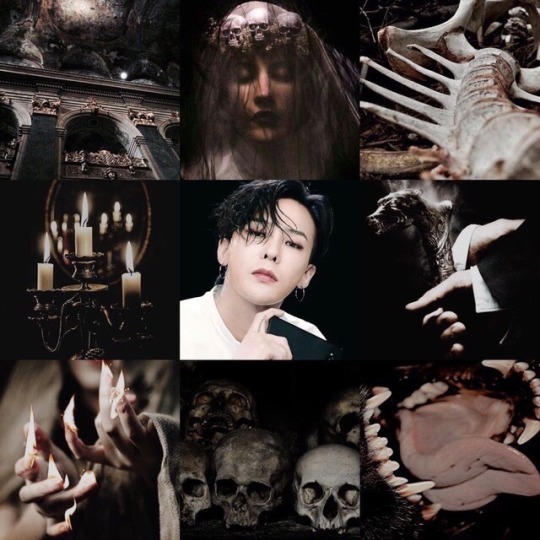
Moodboard by Bae @memoiresofaneternaldreamer
A gold plated Lamborghini whipped around the city corner doing about eighty miles an hour, at least. It’s driver clearly showing no concern for life or death, or for repercussion in any sense of the word. Every head that lined the street turned towards the vehicle with interest. Either from the eye catching car itself, the reckless way in which it was being driven, or the resounding bass from the music that blared from its sound system and echoed down the streets it traveled. The vehicle and its occupant desired attention and that’s exactly what they received.
The car broke suddenly from the street and pulled to a stop against the curb in front of an expensive hotel. Many heads turned back to their own business, but others remained fixated on the car, waiting to see the person exiting the vehicle. Clearly some kind of god in his own right. They had to know who he was.
The switchblade door lifted upward and the driver finally revealed himself. He was striking. His hair was slicked back, showing off not only his smooth undercut but every glorious angle of his face. His cheeks, his jaw, even his chin were sharp, angular, to be admired. While a man on the sidewalk admired the car as he walked passed the woman beside him stared unapologetically at its driver.
The blazer he put his arms through after exiting the vehicle was a sleek, clean black. The shirt beneath popped against it, a bright cherry red. His sunglasses sat low on his nose, showing off his naturally shaped eyebrows. The kind of eyebrows women spent hours trying to shape their own into. His pink lips were lax, resting in an unimpressed line. He ducked back into the car for just a moment, popping out again with a leather bound notebook in his hand. He shut the door and pressed a button on the FOB in his pocket, setting the alarm.
The doorman from the hotel stepped towards him, already looking nervous, “Sir. Excuse me, sir. You can’t park here.”
The man lifted his sunglasses to the top of his head, narrowing his eyes at the doorman, “Can’t I?”
“Errm…” the doorman hesitated. He couldn’t figure it out. This was just a man in a nice suit with a fancy car, he’d seen plenty in his time working here. However, there was something about this specific man that was making him shake with fear. As if he knew, inherently, that the man was not to be vexed without major consequence. “I-I s-suppose you can.”
“Lovely.” the man grinned before pulling his glasses back down his face.
Though he may have had a general look of anger about him, he wasn’t exactly, he just wasn’t fond of a lot of mortals. They were interesting enough as subjects to observe every once in awhile. Which was why if he was especially bored he would pop over from the underworld for a bit, just to watch them. Just for a change of pace. An escape from the humdrum of his day to day. There was an enjoyment he took in learning about them, the strange things that they often did, and the reasons behind it. Trying his best to understand them. None of them he’d found, in millenniums he’d been doing this however, were ever very likable. At least that would remain true until you showed up.
Actually, from the moment he saw you there was something brewing inside of him. As much as he tried to deny it. He’d call it something even more than lust. It wasn’t completely unfamiliar, just something he hadn't felt flow through him for a very long time, not since the first time he’d seen Persephone in the meadow. That fact alone kept him wary of you, considering how things had turned out with her.
Stepping onto the curb that particular day, the day you two met, it was your scent that caught his interest first. A mixture of florals and spice that assaulted his senses the second he’d gotten out of his car. He didn’t even know it was a person that had caught his interest so intensely. It had been his assumption that there was a mixture of aromas, maybe a rooftop garden over a bazaar. Sweet like cherry blossoms with the heat of cayenne pepper. Honestly, he had thought he was just hungry. Having hit peak curiosity, his nose took the lead and he followed the smell around the corner and down the street. He didn’t even bother to look up at the sign above the door before pulling it open. He was surprised to suddenly find himself in a quiet bakery.
The most activity in the building was a study group, six students surrounding a large wooden table covered in papers, books, and laptops. They were buzzing with conversation. Other than that there was a couple at a small table in the corner. Although the way they focused more on their phones than each other left the nature of their relationship vague. For a moment he’d even been distracted by them, wanting to watch them to know how their time together unfolded. There was also a man reading a book near the window, though he was very dull in appearance.
And then there was you.
White blouse tucked into a pair of black ripped jeans, and a black apron tied around your waist, that was covered in some unidentifiable stains. Hair pulled back into a messy ponytail, which swayed across your back as you wiped down tables. Your sleeves were rolled up to your elbows, showing off the tattoo that covered your forearm completely. Bright blues and reds, purples and greens, different types of flowers that wrapped around your arm like a vine. He wondered how far up it went and then quickly shook the thought from his head.
He focused in on you. Your posture, your actions, and subtle facial movements. He grinned as he realized you were talking to yourself. Upset by an argument with your manager earlier, and being ditched by your boyfriend once again had you feeling irritable and left you mumbling to yourself. Mostly it was just the arguments you’d thought to say to your boss hours after the fact, per usual.
You hadn’t even noticed that he’d walked in yet so you continued on with your cleaning, before walking back around the coffee bar. He followed you, quietly standing in front of the counter. He placed his notebook down on the polished wood and then his hands gently on top of the worn leather. His dark brown eyes stayed focused on the crown of your head as you wiped down the shelving below.
“I don’t even need this job, you’re just ruining everything about it that I loved. I’ll just get another bullshit job somewhere else doing some entry level bullshit for a bullshit wage until I can afford my own place and not have to deal with your incompetence anymore which we both know is the real issue at hand and always has been.” You let out a frustrated growl and continued on your rant. “Fucking humans. Worthless, no good, waste of…”
He cleared his throat in an effort to get your attention, unable to remove the small curl at the end of his mouth. “Are you still open or…?”
You popped up from behind the counter, wide eyed with a slight blush on your cheeks. “Hi! Yes. I’m so sorry, I didn’t notice you come in. We’re absolutely open, give me just a moment.”
You turned to the small sink behind you to wash your hands. He had been taken aback by your eyes, left practically breathless. The soul that lingered behind them, he knew that soul, even if he wasn’t sure how. Somehow he knew you and it made his heart flutter in his chest, his brain raced to figure out who you could be.
“Oh good, I was really craving a coffee.” He said slowly, hoping to hide the way his eyes had lingered on you a bit too long.
He watched your reflection through the framed photograph on the wall in front of you as you rolled those beautiful eyes. He was thankful for his impeccable hearing, although he had to keep himself from laughing, as you muttered under your breath, what else would you be here for?
When you turned back to him the smile had returned to your face. “Welcome to Olympus and what can I get for you today?”
An intake of breath so quick and severe left him choking out in surprise. His sunglasses flew from the top of his head in the jolt and he quickly grabbed them before they clattered against the counter. You raised a curious eyebrow at the outburst. Catching his breath once more he looked back up at you, “W-what did you say?”
“Uh, welcome to Olympus...what can I get for you?” you repeated your usual introduction.
“Olympus?” he asked.
“The name...of the bakery you walked into.” you pointed up to the sign hanging from the wall behind you.
It did say it, right there on the black background, in a metallic gold font. Olympus Bakery. It was printed in the kind of typography that was typical of greek themed businesses. He looked around the building again, this time taking in the little details he’d missed out on the first time. The walls were painted in an ombre, blue at the bottom blending lighter and lighter until it was a white at the top giving it the aesthetic of a cloudy sky without any of the usual, cheesy sponged on clouds. Column style pedestals lined the walls every six feet or so holding knockoff, antique greek vases. In between each of the columns a portrait was hung of one of the major olympians.
You watched him as he silently walked over to the nearest portrait. It was of Zeus, standing tall and proud at the top of Mount Olympus. His wavy hair flowing behind him to indicate some invisible gust of wind. Anger showing on his face as he clutched a lightning bolt in his fist, ready to hurl the electric lance down upon his enemy.
Your new guest rolled his eyes and made his final judgement with a scoff before turning around and muttering, “Prick.”
“I’m sorry, was there something I could get for you?” you tried one more time.
He looked back up at you, almost as if he was surprised you were still there, “Oh, right. What do you have here?”
“I- um,” you pointed to the menu again weakly and then sighed in defeat. The attitude typical of many of the customers you recieved. “Cakes and cookies, Sweet breads, regular bread. Bakery…stuff.”
“Specifically?” he asked, amused at your attempt to keep your cool. The look in your eyes was that of someone completely exasperated and annoyed. “I’m so sorry, have I bothered you? I just assumed, I guess, that as someone who works here you would have a genuine interest in the items you sold.”
You couldn’t stop your sneer, “I do.”
“Then what’s the problem? Is it too much to ask what you offer? If it is, why don’t you just try to tell me about one of them? Which of these treats is your favorite?” he asked peering into the display case curiously.
“Everything here is delicious.” you glared at him for a second, unsure why he was messing with you, and then turned to the case. “The cupcake over here, that’s called the Lightning Bolt, for Zeus. It’s a white cake with lemon curd filling and a vanilla, lemon zest buttercream frosting. The muffin here, is Demeter, it’s like a… breakfast muffin. The healthiest thing we offer if you’re into that. It’s just like flax seeds, chia seeds, lots of seeds, some berries and nuts. It’s not bad...just not a favorite.”
He didn’t once look at the case as you spoke about the items, but you didn’t notice. He was too busy watching the way your eyes lit up while you talked about each treat and the combination of flavors they offered. This was clearly your passion, but everything else was taking you away from the joy it gave you. Each treat was named for a god or was a play off of what they ruled over, he couldn’t lie, it was pretty clever. Kitschy but still cute. He wondered if it was something you had come up with yourself.
“...the bundt cake is based on a rum cake recipe,” you were saying as he focused back on your words, “except instead of rum the glaze is made with a red wine reduction, it’s the...”
“Dionysus,” he chuckled, you grinned down at the cake in silent confirmation, “It would be”.
“Big fan of the greek mythos?” you asked finally looking back up at him.
“I don’t know if fan is the right word. I’m knowledgeable on the subject.” he shrugged, “Nothing for Hades then?”
You made a face as you eyed the back of the case, after a second your eyebrows perked, “The ramekin at the bottom. We’re usually out of that one by now. It’s a lava cake.”
He looked down and saw the lone ceramic bowl with the chocolate cake baked inside, “A lava cake? That’s the best you could come up with? Because of course the underworld is all hellfire and brimstone...”
“Hey!” you said clearly offended, “It’s my recipe and it’s really good. And it’s not named for the underworld, it’s made for the actual god. Hades just seems like he’d have a little more bite than the others. So it’s a Mexican chocolate cake, it’s got a little snap from the cinnamon and the chilies.”
“I’ll take it. Give me that last one.” he said definitively.
“Anything else?” you asked before ducking behind the case and reaching for the last of the Hades cakes. He watched your every move like a curious cat. “We have coffee too. Regular brewed, cold brew, espresso drinks...”
“Ten shots of espresso, please.” he said suddenly.
“...with?”
“That’s it.” He watched your face, completely amused, as you went from professional smile to pure disgust.
“Ew.” You couldn’t help yourself.
“Ew?” He smirked. “Do you always react so kindly to people’s drink orders?”
“If you’d ordered a drink perhaps my reaction would have been more kind.” You smiled once more with your clearly ingenuine smirk reserved for customers. “But I’ll get you your espresso shots. Would you like that for here or to go?”
“What’s the difference?”
“Between here and to go?” You asked furrowing your brow. “Here means you’re drinking it here, to go means…”
“I mean what changes about my drink. I know what it means to stay or to leave. Do I look stupid to you?” He asked, but not without some amusement so you knew he was still being quite playful.
“To go, you get this recycled materials paper cup. For here, a fancy white cappuccino cup that should be big enough to fit your ridiculous amount of espresso.” You motioned to the stack of cleaned cups next to the machine.
“And a conversation with you?” He asked.
“A what?”
He let loose a small laugh at your reaction. “If I stay here, will you talk with me awhile?”
“Well… okay.” You agreed, “I would kind of enjoy the chance to see you attempt this drink, and someone should be nearby when your heart attack inevitably comes.”
“Then I’ll take that for here.” He said pulling out a stool that ran along the counter.
“And what’s your name?” You asked before tucking your lip beneath your teeth and grabbing a porcelain cup. He grinned arrogantly and you felt the need to clarify. “For the order…”
“Of course. You can call me,” Hades thought for a moment about which pseudonym he would be using this time before responding, “Jiyong.”
153 notes
·
View notes
Text
@shippinglifeaway replied to your post “I think the expression that best represents Garou’s re: ‘semblance of choice”
there's a really cool yt video that analyzes this concept of 'societal-constructs as the bad guy' in media (specifically in wall-e) that really dives in on this concept with way more eloquence that I could ever muster haha (https://www.youtube.com/watch?v=Z1-vPQKwXbY), in case it sways your interest! :D
Ooh thank you! :D (That yt channel is a great resource for media analysis/critique in general, so lots of insightful content to watch there!) It really does bring more interesting layers to think about here, especially when it might explain how certain opm characters behave/react or unconsciously adhere to the ‘rules’ of established social systems they feel they can’t break out of, especially when we know how ONE tends to put subtle social commentary like that in his works anyway. It ultimately brings to mind, who is the actual ‘villain’ bringing conflict to the characters in the story? Could it really be the overarching effects of that social ‘system’? And if so, then who’s the actual ‘hero’ who can rise to help break people ‘free’ from this system, to lead change for the better? :O
It’s interesting when this type of commentary comes from the perspective of a Japanese writer (ONE, who’s also a millennial), and while I can’t presume to know or speak for what’s beyond the realm of what he’s provided in the text (esp coming from a western background), what I can do is notice there’s definitely an orderly structure to what ONE has constructed in his opm worldbuilding.
For example, how each city is named/ordered in lettered districts, how the HA’s purpose is to organize (not raise) heroes in a rigid/tiered hierarchical system, how even the being called ‘god’ has (been theorized to) set hard ‘limits’ upon all creatures to control their growth... But how importantly too, how such systems themselves aren’t inherently ‘bad’ either, because they can help keep things managed and running smoothly...and yet, on the other hand, we can see other unfortunate effects from them too, such as the dark ninja school raising assassins (presented as a bad/evil thing that needs to be eliminated), and the rampant monster phenomenon that keeps disrupting things and causing chaos (which is also shown with the need to be exterminated). It’s possible they’re all types of reactions fighting back against such systems of control too.
As to how all this relates to the Death Gatling & Garou stuff as discussed before, and the socially accepted, established ‘roles’ they might be playing or adhering to as hero vs monster (which may or may not be by choice), it’s also interestingly presented from ONE when neither side/individual is clearly ‘good’ or ‘bad’ either (just who should the viewer root for here? Perhaps it’s supposed to be arbitrary/confusing with the protagonist flipped that way on purpose).
So let’s take a look at it from Death Gatling’s view first. He’s working as part of the HA, and nicely performing his role/duty as a hero, yet already he can feel the system is unfair when they’re all heroes doing their best, yet somehow it’s the S Class who still get special privilege. He has the moral right to feel that way (and that unfairness is something Garou could probably sympathize with, IF they could properly communicate eye-to-eye), so it’s rational (and very human) for him to behave this way and want to prove himself as equal to all other heroes. Unfortunately, his method to make a difference and better name for himself, whether he even realizes or likes it or not, still adheres to the rules of that very HA system (of earning points); it does not ‘break free’ or try to challenge/change the established system he’s upset about. And THAT feels like another reason for Garou’s disappointment in him. When a hero’s behavior ends up no better than the established rules of the (unfair) system he’s a part/product of. Or, in another way, by Garou facing him as ‘the monster,’ he still couldn’t push ‘the hero’ into performing, or ‘breaking free,’ any better than that result. HRMM!! 👀
Now this ties directly into Garou’s ‘lack of confidence’ too, because what he really wanted to achieve by fighting heroes, was to ultimately find/influence someone else who could rise to face him with the type of true heroism he wanted. To bring about the ultimate good that way, because...he did not have the confidence to follow through and become that ideal hero himself. When he likely believed the monster role was all he could ever be (by a combo of those societal pressures and what happened in his past), even if he never honestly liked performing that role either (not being true to himself when he’s not an evil person at heart). So he resolves to have someone else rise to ‘break free’ and change the system rather than directly do it himself (even if that means resigning himself to be miserable and potentially lead to his own death by the end of that path). However, now that he’s finally had a needed wake up call and realized some hard truths, he does not have to adhere to that monster role any longer. This is his choice now to ‘break free’ and decide what to do next.
But it gets even more interesting, because even when there’s a hero strong enough to come forth and stop his monster plans (Saitama), who literally has all the outlier power to break free from everything, that’s still not good enough (for what Garou wants). Because as it turns out, even the all-powerful Saitama is still bound by that system too. D: Saitama’s current passive lifestyle, whether by choice or not, still has him on the ‘path of least resistance’ (as in that video). While he still believes it’s best to do what you want, it’s either by convenience or him not wanting to get further involved anymore that he still chooses to stay with the HA and go along to whatever happens. (Even when he’s still not satisfied and wants more...) When by all means, if there’s anyone with the power who could rise up and change/influence things for the better, it’s him. And so interestingly, perhaps it’s not supposed to happen directly by himself either (on an individual basis), but rather through the positive changes he makes to everyone else he comes to meet and influence for the better (ie making connections with others, which is what we can gradually see happening).
I don’t know where ONE plans to take things or how he intends to end the story, but it’s really interesting to see it from the perspective of him exploring all these themes. There’s still plans with the Neo Heroes challenging the HA’s system, the prophecy that the ‘earth is in danger,’ and whatever else might happen too, because tensions are certainly building towards something breaking soon. And there’s still Garou, who’s yet to find his answer and decide how best he can make a return to properly achieve what he wants now. Is Saitama going to become that ‘hero’ of the story who steps forward to change and save the world (in ‘one punch’), or might it become someone else who can take the lead, or who can influence change on a gradual, yet smaller collective scale? Maybe it’ll take the contributions from everyone acting together in some way too. Either way ONE plans it, and even if he doesn’t end things on such a ‘grand’ scale (such as if he chooses to keep it humble instead), I think he’ll come up with a positive, hopeful solution to things that’ll be both worthwhile and fun to look forward to.
#shippinglifeaway#replies#opm#garou#saitama#meta#webcomic spoilers#long post#whoops this got pretty long#but i definitely found the perspective interesting#(esp if it ends up explaining more about the whole of opm itself)#so i had to sleep on that video to make a proper in depth response ahaha
21 notes
·
View notes
Text
Rosie Lee Tompkins: A Retrospective at BAMPFA
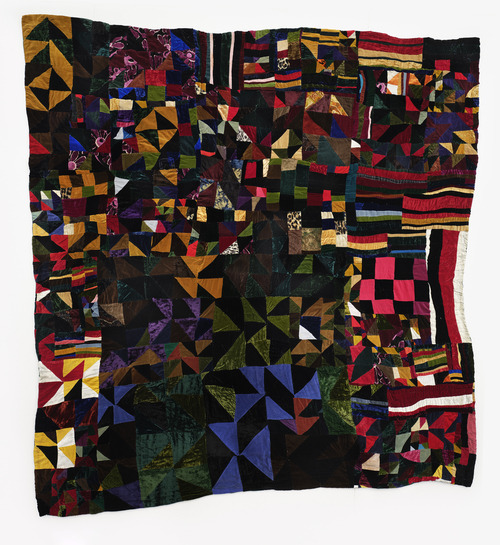
Untitled, 1986
Walking through the Rosie Lee Tompkins exhibit that just opened up at the Berkeley Art Museum and Pacific Film Archive in Berkeley, one phrase kept reverberating through my mind: “an ordinary mystic.” There is a spiritual element to this artist’s quilt work that goes beyond her frequent incorporation of bible verse references stitched onto fabric and weaves its way through every subtle connection made in each joined-together piece of colorful texture. You can sense it in just one of the quilts, but when you view the 65+ quilts hung together on the wall in one sitting, it permeates your awareness in a deeply profound way. The artist combines her own diverse cultural background with the influence of the upcycled/repurposed culture of Bay Area arts scene to create a set of brightly-colored, vivid, and vibrant quilts that emanate their own energy.
Tompkins applies her Christian background in the irregularly embroidered numbers and letters cascading across the surface of many of her quilts. Rosie Lee Tompkins would sit down to a quilt, with both a theme and a specific human in mind, and she would meditatively and mindfully stitch together the varied pieces of fabric into something more than the sum of their parts; it was a spiritual practice. She would take the fabrics that others in the Bay Area were giving away or throwing out, find a theme within them, and bring new life to them through her creations. Her work was spiritual, meditative, and intentional. Tompkins’ work evokes a sense of everyday spirituality; it is also materially beautiful and certainly doesn’t require a religious interpretation if you yourself aren’t comfortable with or interested in one.
Tompkins' quilts caught the eye of Bay Area psychologist and art collector Eli Leon who had an ardent passion for African American quilts. When he passed away in 2018, he willed his entire collection, consisting of more than 3,000 quilts, to BAMPFA. It was a surprise to the museum but one that opened up a grand opportunity to delve deep into this niche of art. Of those 3,000 quilts, approximately 500 were created by Rosie Lee Tompkins. The museum curators knew that sharing the work with the public might best begin by introducing us all to her body of work. Although there are references to Leon in the collection, the curators intentionally made Rosie and her creations the star of this exhibit. A second exhibit is in the works for 2022, which will display a greater range of artists from the quilt collection along with additional information about Leon.
Exhibit co-curator Elaine Yau has been delving deep into a socio-cultural, historical perspective on the artist’s work. Until relatively recently, the art world looked at Tompkins solely from a formal perspective. This was due in large part to the fact that Tompkins wanted to keep her life private. In fact, Rosie Lee Tompkins is actually a chosen pseudonym for the artist born Effie Mae Howard. Notably, although she was called Rosie throughout her artistic life, she has embroidered her original name, Effie, on to the borders and faces of many of the quilts that you’ll see in the exhibit. Nevertheless, she refrained from engaging extensively with the art world. This is not to suggest that her work hasn’t been seen before. Co-curator Larry Rinder remembers first coming across her work in 1996 at a Richmond Art Center exhibit by Eli Leon, an experience which moved him so much that Rinder went on to help launch her first solo exhibit at BAMPFA. However, it is only since Tompkins’ death in 2006 that the art world has been looking, as Yau has, at the way the artist fits into the narrative landscape within which her work was created.
Yau emphasizes that we have to consider Tompkins’ work in light of The Great Migration as well as her experiences in the Bay Area as an adult. Effie Mae Howard was born in Arkansas in 1936, a child of The Great Depression and World War II. She learned quilting as a child, taught by her mother, passed down from a lineage of African-American women living in the South. She left the region in hopes of better opportunities, ending up in the San Francisco Bay Area by way of Chicago then Milwaukee. Once she arrived here, she was influenced by the late 1970s urban arts scene. In particular, there was a culture of re-use (or what we would now term upcycling). She would head to Thrift Town and Value Village and the many flea markets throughout the Bay Area, collecting fabrics and notions as she went along. She stitched together her own identity as an artist, joining her mother’s visual and tactile quilting lessons with her new Bay Area experiences and inspirations, and the result is a body of work that shows both consistency and growth over time.
Untitled, 1968, 1982-3, 1996
There are a couple of quilts in the exhibit that date to the 1970s but most of them were created in the two decades starting in the early 1980s and leading nearly up to her death. The first two quilts that you’ll see as you enter the exhibit are early pieces that instantly tell you a lot about what you’re going to find as you venture along. Both pieces are large quilts that at first glance look chaotic. They each incorporate a range of different fabrics as well as utilization of a variety of techniques drawn not only from quilting but also including embroidery and other handcrafts. Tompkins’ pushed the boundaries of what a “quilt” could be. Once you realize that there is a theme, you can see that Tompkins set parameters for herself, but then allowed herself to go wild within those parameters, and it is this exact combination of restraint and fluid creation that makes her work so uniquely hers.
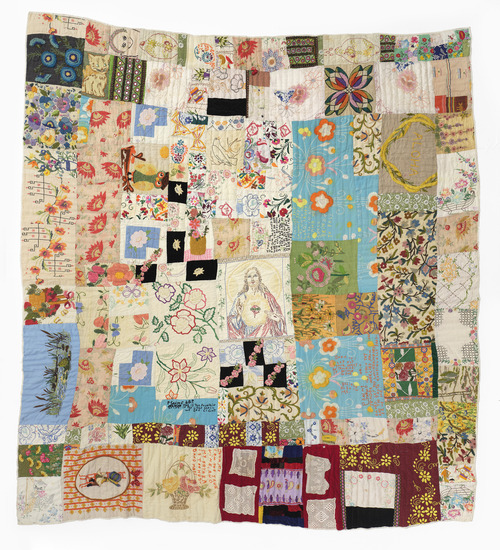
Untitled, 1970s, scriptures
The first room offers just a taste of what is to come. We see Tompkins’ creativity flourish as we enter the second room, which is themed around assemblage and applique work. In this room, we see Tompkins’ take on a classic “crazy quilt.” Seeing several pieces hung together, it becomes obvious that the artist has a broad vocabulary for quilting, and she continues to put her own spin on traditional techniques. Some pieces are dense and almost cluttered, but she never loses track of her sense for composition and shows exquisite skill in her variation of it from piece to piece.
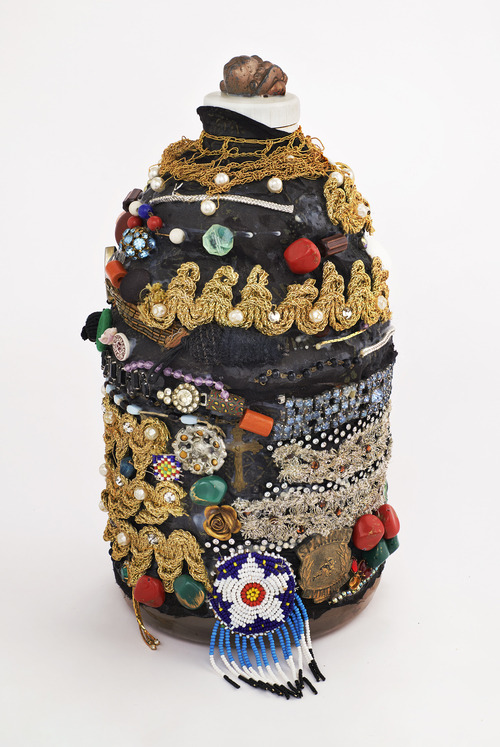
"Jewelry Christmas tree" bottle, 1996
Make sure that you take the time when you are in the applique room to turn your attention away from the quilts for a moment and towards the case in the center of the room where half a dozen “jewelry Christmas trees” are showcased. These were found in a closet of her home, perhaps originally intended for her eyes only, but they are jewels that glitter so bright that it would have been a shame to keep them stuck in a closet. Tompkins had a love for glitter, sparkle, ribbon, sequins, and all things a little bit extra. She combines them densely on these sculptural forms, creating a three-dimensional version of her quilt style.
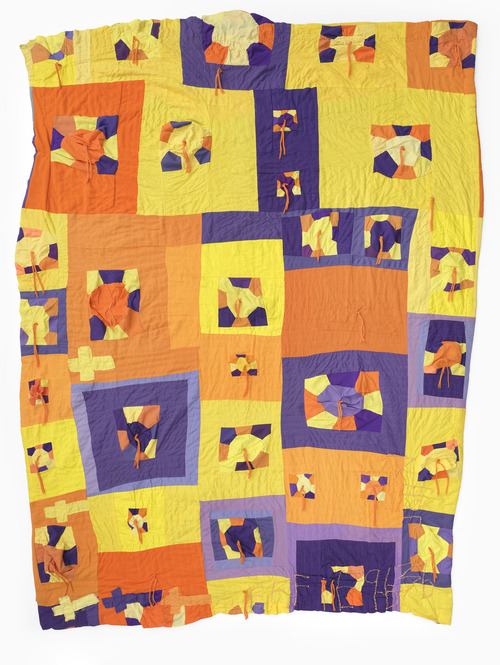
Thirty-six Nine-patch, Three Sixes Combination, 1999, quilted by Irene Bankhead
The next room of the exhibit can’t be missed - you couldn’t fail to notice it - because of the three bright yellow/orange/purple pieces that stand out in the corner. The curators have called this room "Personal Symbolism," and it is the best representation in the exhibit of how Tompkins combined her traditional Christian beliefs with her personal lived experience as well as other elements of transcendental, mystical spirituality. These pieces are called The Three Sixes. They loosely represent three people in her family who all had birthdays with the number six in them. The first is her own birthday: 9/6/36 which seems to have taken on a magical quality for her. She stitches it frequently into the surface of her quilts, sometimes written out directly and sometimes written backwards. The second color and number in the Three Sixes represents her grandfather, a family member she grew up with. The third represents a number of different people - a great uncle, a cousin, a brother. In any case, there is a magical quality to the numbers that Tompkins draws from. However, co-curator Yau points out that sometimes the artist took liberties with her math. For example, there’s a piece that’s a “Thirty-six Nine-patch quilt.” The nine-patch is a traditional quilting technique. Tompkins’ often puts her own twist on classic techniques and this is no exception. In this case, she’s worked the numbers of her birth date in to create a set of 36 9-patches, except that as Yau points out, there are strictly only 33, and you have to count certain yarn ties to get to the “correct” or intended 36. Nevertheless, the gist is there, the cohesion between all of the pieces in the series is undeniable, and there is something a bit mystical about the number play at work here.
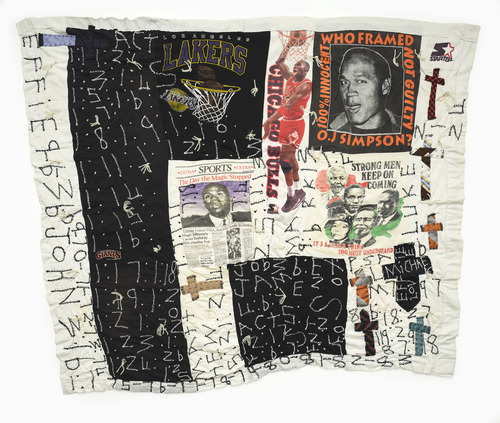
Untitled, 1996 (circa)
When we head to the next room, we see a visible shift in the artist’s work. The pieces collected here represent her cultural concerns. Mostly created in the late 1990s, Tompkins has composed quilts with specific themes in mind, although it’s not always easy to guess exactly what she was trying to say. For example, there is a piece with a big image of OJ Simpson right at the top. The piece includes other prominent Pan-African leaders and celebrities. There is clear thematic cohesion and yet it raises questions as to what precisely she was trying to say. Although this is a political piece, it is also highly personal. Her name, Effie, is stitched not only on the border but also on a cross that says “Michael + Effie + Love” (likely referring to the nearby image of Michael Jordan). And this is where all of her life’s work seems to coalesce, as she combines a deep mindful meditation with both personal and socio-political issues.

Untitled, 1996, quilted by Irene Bankhead
Another quilt in this section prominently features an image of the Kennedy brothers with Martin Luther King Jr.. It is surrounded by several different versions of the American flag, positioned both vertically and horizontally. Within this, though, the thematic stripes of the flag are repeated in other fabrics including an Indian-inspired batik and a Mexican stripe drawn pulled from serape fabric. There are pastoral scenes here that seem almost colonial with a Latin American reference in a piece of fabric showing flamenco dancers. The statements here are bold and striking.
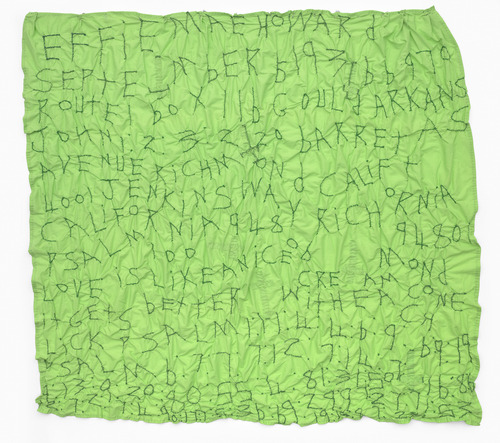
Untitled, 2002 (circa)
In her latest years, Tompkins’ work became more overtly religious. The final room consists of many pieces incorporating crosses and other religious symbolism. Then there are two striking pieces at the very end that bring a sense of closure to the entire show. The penultimate piece is a non-quilted single-piece embroidered green-on-green that combines her personal details (including her name and address) with Christian scripture verses as well as a quote that “love is like an ice cream cone; it gets better with every lick.” The last is a black-on-black embroidered quilt that is slightly reminiscent of a funeral gown. Compared to the bright colors, textures, and pictorial narratives of the other rooms, this is understated and yet astoundingly powerful. We see the artist come full circle as we circle through the rooms of this exhibit.
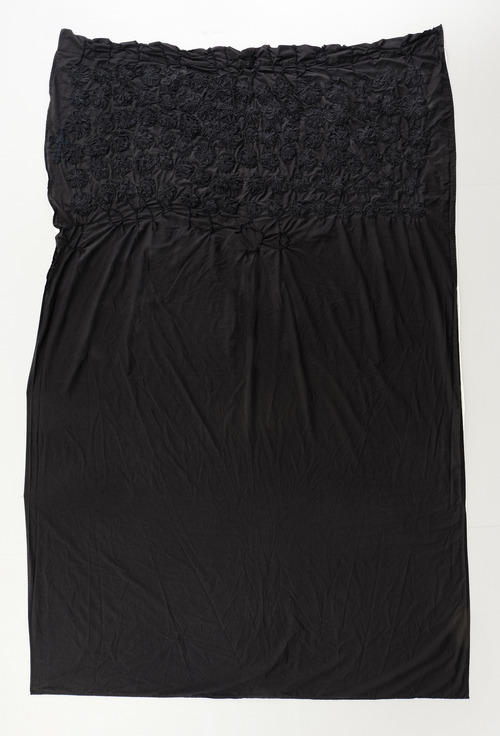
Untitled, 2005
Rosie Lee Tompkins: A Retrospective is on display at the Berkeley Art Museum and Pacific Film Archive (BAMPFA) at 2155 Center Street in Berkeley, CA. The exhibit runs from 2/19/20 - 7/19/20. It is the largest-ever retrospective of the artist’s work.
BAMPFA galleries are open 11-7 Wednesday - Sunday. General admission is $14 with discounts / free admission available to varied populations including students, UC Berkeley staff, seniors and children. Galleries are free to all on the first Thursday of every month.
Special events for this exhibit include:
Colloquium: Re-visioning the Art of Rosie Lee Tompkins, 2/29/20, 2 pm
Fabric Postcard Collage Workshop, 3/7/20, 11 am
Improvisational Quilt-Print Making Workshop, 4/5/20, 2 pm
And more. Details on BAMPFA website.
By: Kathryn Vercillo
#berkeley#berkeley art museum and pacific film archive#rosie lee tompkins#textile art#textile artist#quilting#press preview#san francisco bay area#art museum#art exhibit#art history#history of art#sartle news#5 women artists#women in the arts
4 notes
·
View notes